Veneto is that region in the northeast of Italy where everything is on your doorstep.
The beautiful city of Venice, the Adriatic Sea, Lake Garda, the mountain range of the Dolomites, as well as many cities of art, medieval towns, and picturesque villages, are just a few of the travel options here!
So, in this blog post today, I want to share with you the top 15 places to visit in Veneto. This way you can pick the exact destinations you want to see depending on the type of holiday you are planning. This could be an immersion in Italian history, art, and culture, a relaxing vacation on the beach, a romantic city break, a family adventure, or a fun experience with lots of activities.
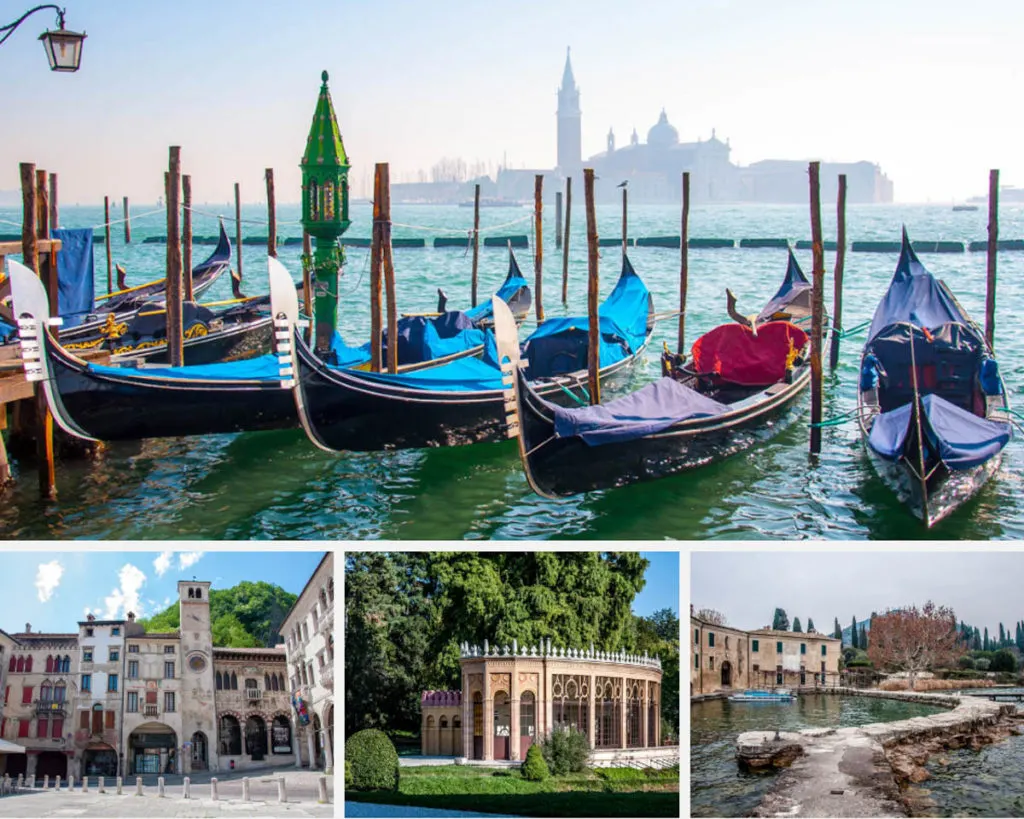
Captained by its capital – the dreamy city of Venice – and with a long list of hidden gems and beautiful destinations, Veneto is a delight to discover during a short break, an intensive week of sightseeing or a longer period of relaxation coupled with exploration.
The choices of what to see and where to go in Veneto are endless. Here are the main ones:
- the cities of Venice, Padua and Verona with their many layers of history and art.
- Cittadella, Este, Montagnana, and dozens more walled towns with medieval castles and centuries-old buildings with frescoed facades.
- Lago di Garda – Italy’s largest lake with shores dotted with cute towns, small beaches, citrus gardens, and olive groves.
- the delta of the River Po – Italy’s longest river where flocks of flamingoes roam.
- the Venetian Lagoon – with its many islands each with its unique heritage.
- the Adriatic Sea – flanked by endless sandy beaches stretching under the hot Italian sun.
- the Dolomites – where peaks, valleys and lakes come together in an unspoilt, beautiful landscape.
Add to this Veneto’s three international airports (one next to Venice, another near Treviso, and a third by Verona) and this northeastern Italian region – a maximum of two-hour flight away from most major hubs in Europe – becomes not just a must-see destination but also an easy to reach and so very enjoyable to explore place.
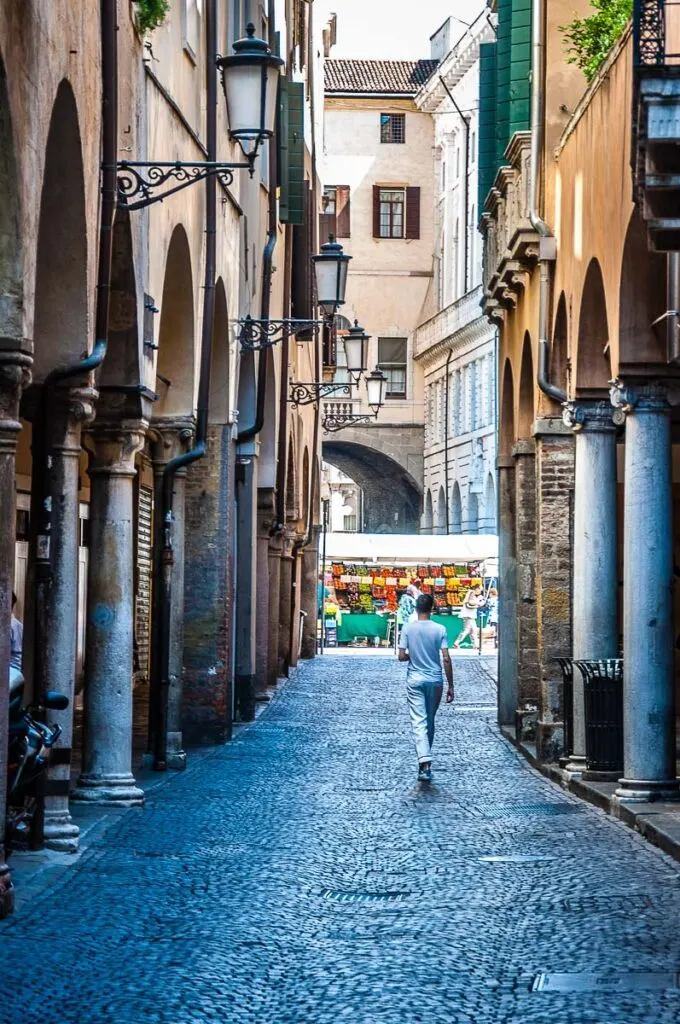
Scroll down to browse through the region’s large cities, pretty towns, artistic heritage, hidden corners, and spots of natural beauty.
Right at the end, I have also included an essential travel guide with practical information about visiting Veneto – where to stay, what to eat, how to get around the region, everything is covered. Including a sample week-long itinerary.
It’s all based on my six years of living in Veneto. I spent this time travelling around the region and exploring it in depth. I hope that all the information in this blog post – all personally tried and tested by me – will give you lots of ideas for exciting holidays in this corner of Italy. Plus, the knowledge of how to organise your travel most smoothly and enjoyably.
Have a look!
Where in Italy is Veneto?
Let’s start by pinpointing on the map the exact location of Veneto in Italy and Europe. This way you will have a clear idea of where its main cities are on its territory and can check how long it takes to get from one to another.
Veneto is one of Italy’s twenty regions. It is also one of the eight Italian regions that make up the northern end of the country. If you imagine Italy as a long over-the-knee boot, the north corresponds to its wide upper band. Veneto is more or less just above the back of the knee and covers the back of the lower thigh.
To the east, Veneto borders the Adriatic Sea and most importantly – the Venetian Lagoon where the region’s capital, Venice, was first settled in the 5th century AD. To the west, Veneto borders the Italian region of Lombardy and a long strip of the boundary cuts across Italy’s largest lake – Lago di Garda. To the south of Veneto stretches the region of Emilia-Romagna. To the northeast stands the region of Friuli Venezia Giulia, to the northwest is the autonomous region of Trentino-Alto Adige, and to the north – there is a small land border with Austria.
The above map shows you the location of Veneto in Italy as well as the region’s main and lesser-known destinations. You can use it just like any other map in Google Maps – you can zoom in and out, calculate directions, and even open it in a new browser tab for more convenient browsing.
Top 15 Places to Visit in Veneto, Italy
Pin for Later!
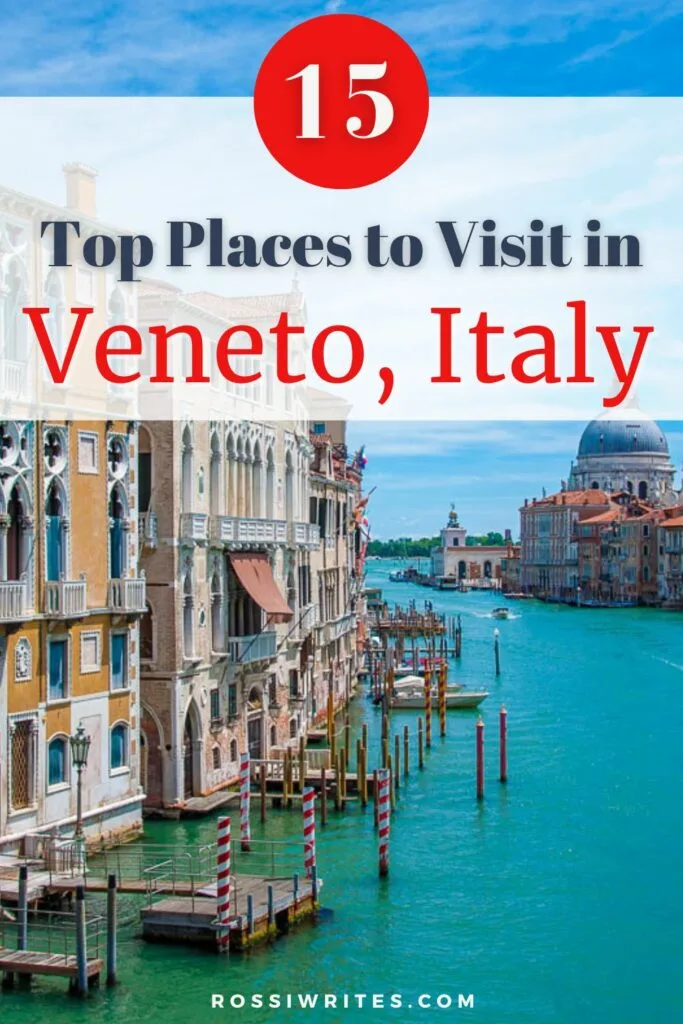
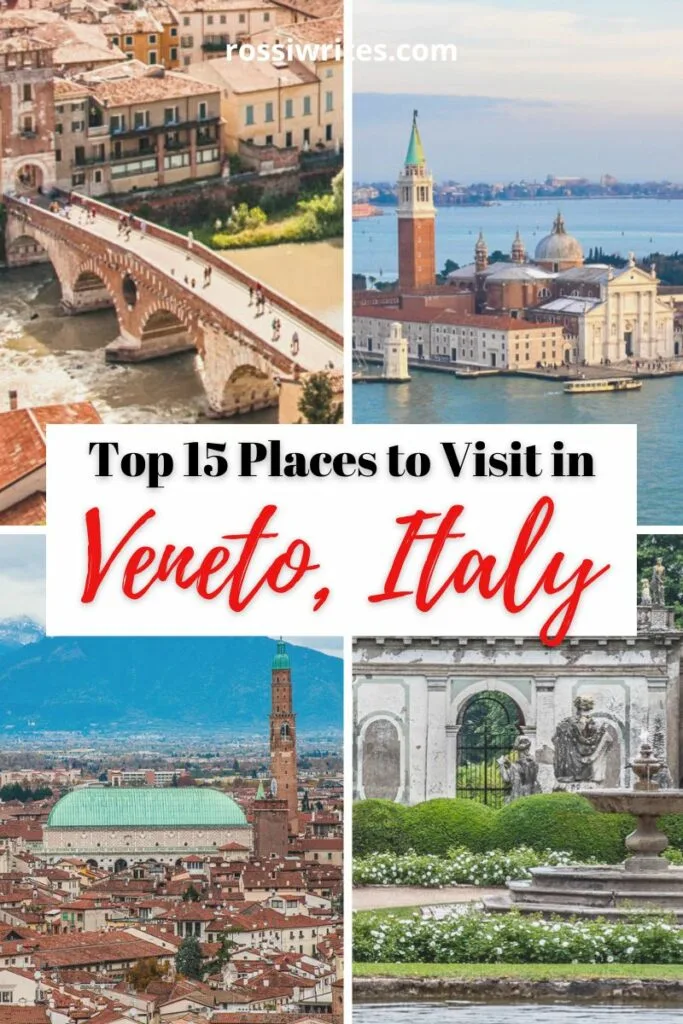
1. Veneto’s Top 3 Cities
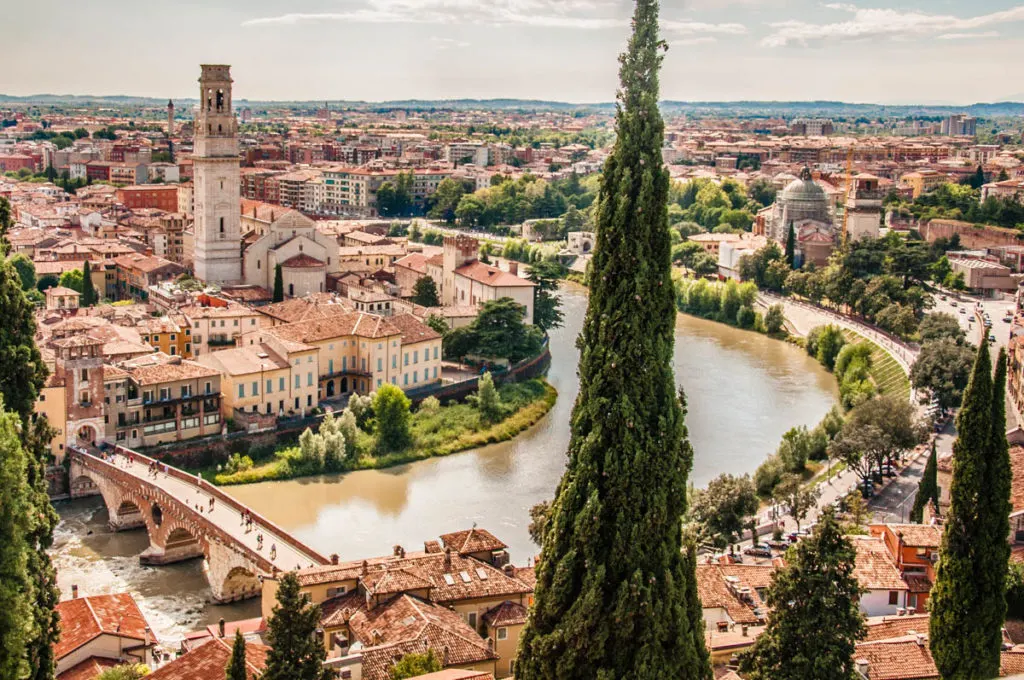
Veneto has three main cities which are world-famous on account of their history and beauty. They are Venice, Verona, and Padua. Each one of them deserves at least a couple of days of intense exploration and sightseeing. The more you learn and see of them, the more there is to learn and discover.
These three cities are especially satisfying to visit if you have an interest in art, ancient, medieval, and Renaissance history, and food traditions. They are also very beautiful – each in its inimitable way – and allow you to experience the Italian dolce vita from different angles.
So, in a few words, here is what to expect when visiting:
Venice – once this was the head of a superpower that for more than a thousand years ruled over the Mediterranean Sea and large swathes of land. Nowadays, Venice is one of the most famous tourist magnets in the world. Built on a cluster of 118 islands in the Venetian Lagoon, the city captivates with its canals, elegant facades, and a huge repository of art.
Venice attracts millions of visitors each year eager to see its main landmarks, marvel at its architecture, enjoy a romantic experience or simply snap the ultimate selfie. At the same time, the City of Canals has many hidden corners and little-known gems to discover one by one just off the beaten track. This is a destination that needs to be seen more than once at different stages of one’s life.
With its maze-like urban plan, dozens of museums and churches, curious stories, unique local dishes, and soul-inspiring views, Venice reveals itself to you in many, often mysterious ways.
I have written extensively about Venice on this blog. My ultimate travel guide about the City of Water contains links to a huge quantity of useful travel information – from how to orient yourself in Venice to the best things to do here. Have a look!
Verona – known as the City of Love and the City of Romeo and Juliet, this is a multilayered destination that hides many lovely surprises.
At its heart is a majestic Roman arena which nowadays serves as the world’s most exclusive opera stage. Medieval squares flanked by frescoed buildings make Verona an utterly charming city to visit. The imposing cathedral is right next door to the world’s oldest library – the Biblioteca Capitolare. An outstanding art gallery is a must-see inside Castelvecchio – an imposing medieval castle linked to a mighty bridge over the fast-rushing River Adige. The bird’s-eye views from Castel San Pietro make you fall in love with Verona time and time again.
This city in Veneto also has a lively social atmosphere. With bars serving apericena – aperitifs and a large selection of appetisers to double as dinner – people stay out late into the balmy nights. In winter, an excellent Christmas market takes over the historic centre. Spring comes with a large-scale wine festival.
Verona is also a great base for explorations deeper into the region of Veneto. A stone’s-throw away from Lake Garda and an easy train ride away from the other main cities and smaller towns here, you will be spoilt for choice in terms of day trips.
Padua – the popularity of this large city in Veneto is growing year after year. It has a lot to offer including the oldest indoor food market still in operation in the world. You will find it on the ground level of Palazzo della Ragione where pasta-makers, fish-mongers, butchers, and cheese-sellers have been selling their wares for over eight centuries.
The city is also famous for its 14th-century fresco cycles which are a UNESCO World Heritage Sight. You will find them in ancient buildings dotted around the historic centre. Among them, the Scrovegni Chapel stands out. Fully frescoed by the Florentine painter Giotto and his workshop between 1303 and 1305, it is considered to be the spark that inspired the creative expression of the Italian Renaissance.
Giotto’s skill in depicting human emotions leaves you deeply touched as you follow fresco by fresco the biblical stories under a sky painted with the highly-prized in the Middle Ages ultramarine pigment and dotted with gold eight-pointed stars.
Padua also has Italy’s second-oldest University where you can see the world’s oldest permanent anatomical theatre and the podium from which the polymath Galileo Galilei taught his lectures during his 18 years in the city. The world’s oldest academic botanic garden (another UNESCO World Heritage sight) is a short walk away on foot. On the way, stop at the Santo – an imposing basilica dedicated to St. Anthony of Padua which is an important pilgrimage site and beautifully decorated with priceless frescoes and other works of art.
I love Padua and have spent many happy moments exploring everything that this underrated city in Veneto has to offer – from its excellent coffee and cakes to its outstanding works of art. In my blog, you will find several detailed posts about Padua. Have a look!
2. Veneto’s Smaller Cities
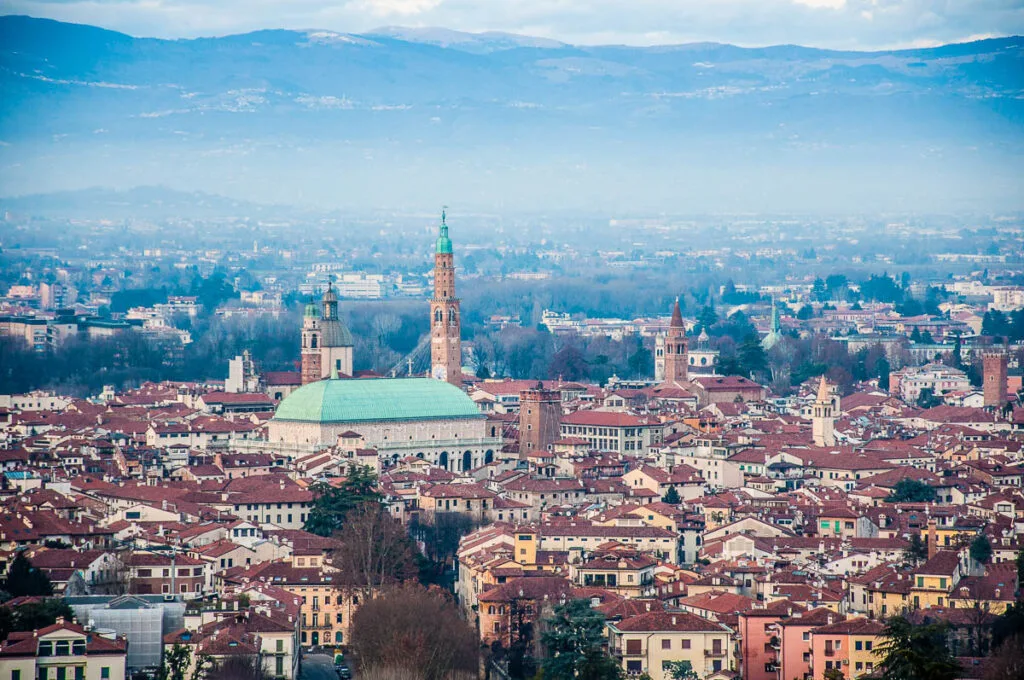
The best thing about the region of Veneto in Italy is that the size of a local destination does not define the amount of history, the number of excellent sights, and the portion of beauty you are going to find in it.
Veneto’s small cities are a case in point. Very walkable and easy to reach by train from Venice, Verona, and Padua, they have charming historic centres, long lists of must-see landmarks, and are often right in the bosom of nature. Surrounded by tall mountains, crisscrossed by rivers, and dotted with elegant historic houses and imposing towers and churches, these small cities are great to visit on a day trip and can add many unforgettable experiences to your travel memories from Veneto in Italy.
Here are five to give you some ideas (for more have a look here):
Vicenza – the City of Gold and the renowned architect Andrea Palladio, Vicenza is where you will find outstanding architecture and some of the finest jewellery shops in Italy. Built on Roman foundations, the city truly prospered during the Renaissance.
Nowadays Vicenza is a great day trip to spend enjoying some excellent museums, looking at Palladio’s buildings, and shopping for a piece of jewellery or two.
I am very fond of Vicenza as this is where I lived during my six years in Veneto. The city is a great base for day trips in the area as it allows you to reach quickly the region’s large cities and a myriad of small destinations.
Treviso – widely known for its convenient low-cost airport, Treviso is truly worth a visit. Historical buildings and long arcades line the city’s cobbled centre which is crisscrossed by several canals and surrounded by ancient fortifications.
The rich cultural and social life is palpable in the air. The civic museums regularly organise important art events and must-see exhibitions. A lively Carnival takes place at the end of winter. A music festival closes each summer.
Any time you come, make sure that you eat your fill of tiramisu – Treviso’s culinary gift to the world. And if you like prosecco, you will be in heaven, as this sparkling Italian wine is produced in the vineyards in the province of Treviso.
Bassano del Grappa – this is a very picturesque small city on the hilly shores of the River Brenta. Founded millennia ago, today Bassano stands out with its medieval and Venetian architecture. There is a ruined castle (used for opera performances each summer), fortified city walls, lovely cobbled piazzas, tall towers, powerful city gates, and many old buildings with facades covered with faded frescoes.
While it takes its name from the nearby mountain Monte Grappa, Bassano is also where you can taste some of the best grappa in Italy. This is a potent alcoholic drink made of grapes and there is even a museum in town dedicated to its production. The local ceramics industry has centuries-old traditions and if you wish, you can get a nice piece of pottery to take home with you to remind you of your Veneto adventure.
Belluno – if you love mountains, you will love this small city in the Italian region of Veneto. It is known as the Gateway to the Dolomites, it’s built on a hilltop and has a dramatic backdrop of craggy peaks.
The city has a lovely historic centre but it is also a great starting point for trips to ski resorts, mountain lakes, and picturesque villages.
A short drive away from Belluno you can visit Pieve di Cadore’ – the small town where the famous Renaissance painter Titian was born. This is also where several centuries ago people began making spectacles using local rock crystal. In the process, Italy’s eyewear industry was born.
Rovigo – known locally as the City of the Roses, Rovigo is traditionally ignored by the mass tourist and yet it has a lot to offer if you want to delve deeper into the history and art of this corner of Italy.
Palazzo Roverella is a must-see sight here. It houses a free art gallery with masterpieces by Giovanni Bellini, Titian, and Tintoretto. The Torre Dona’ dates back to Rovigo’s heyday. 66 m high, it is one of Italy’s tallest medieval towers. During your visit, don’t miss the octagonal Rotunda church. This Renaissance building hides an exuberant Baroque interior decorated with large canvases depicting important personalities related to the civic history of Rovigo.
The city is also a gateway to the Delta of Po – the longest Italian river. Its delta is where you can see flocks of flamingoes, sunbathe at one of the many sandy beaches, stay in a summer resort, and visit the Botanical Garden of Porto Caleri.
3. Veneto’s Roman Heritage Sights and Towns
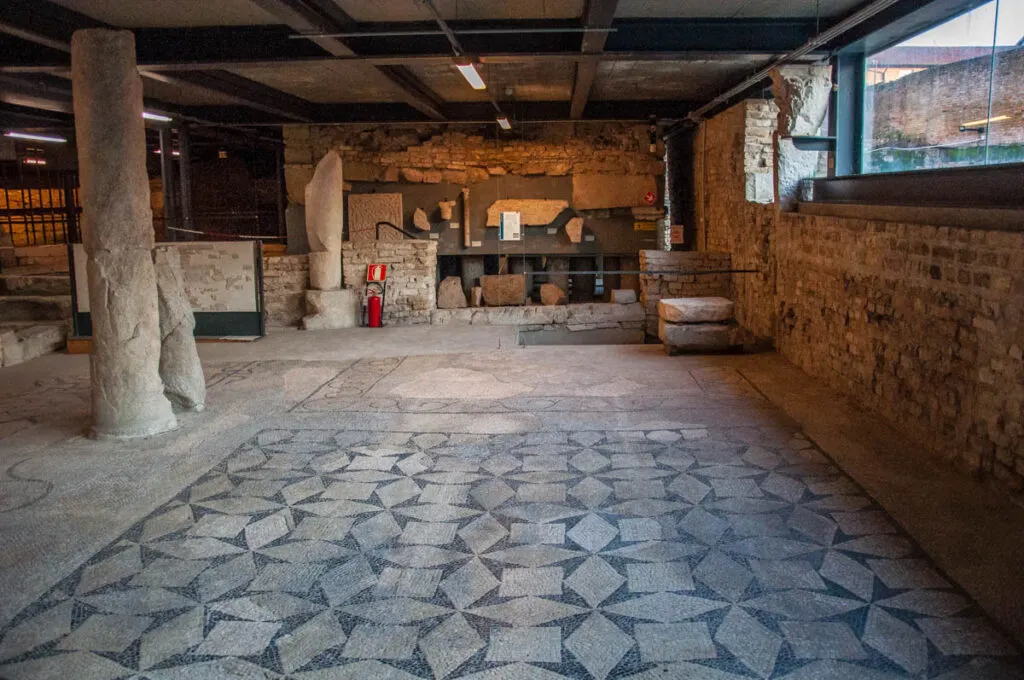
Veneto has an extensive ancient Roman heritage. Artefacts, ruins, and whole preserved structures from the Roman era can be found all around the region.
The tribes living in what nowadays is Veneto’s territory allied themselves with the Roman Republic as early as the 3rd century BC. They received full Roman citizenship in 49 BC and then remained part of the Roman Empire until its fall in the 5th century AD.
Most of Veneto’s cities and towns either were founded by or flourished under the Romans. Their names have Roman origins. For example, Padua was called Patavium, Treviso – Tarvisio, and Vicenza – Vicetia.
In every town or city of Veneto (even in Venice which was founded after the fall of the Roman Empire) you can easily come across ruins and vestiges of this important ancient civilization. For example, in Verona alone, you can see the beautifully preserved Arena di Verona, the ancient Roman theatre, the Roman city gates Porta Borsari and Porta Leoni, the reconstructed Roman bridge Ponte Pietra, as well as a medley of excavations and artefacts all over the city.
Venice not only has a priceless Roman collection in its National Archaeological Museum but they say that the famous Rialto Bridge was built with stones extracted from the ruins of the ancient Roman theatre in nearby Padua.
Whatever is left of it, nowadays lies at the bottom of the elliptical canal which graces Prato della Valle – the enormous square at one end of Padua’s historical centre. Across town from it stands the famous Scrovegni Chapel (see point 1 above) which is customarily known as the Arena Chapel in English as it was built on top of the ruins of Padua’s Roman arena.
If you have a deep-seated interest in ancient history, a trip to the region of Veneto in Italy is a great idea. You can pepper it with exciting visits to both well-known Roman sights here as well as to little-known hidden gems. A case in point are these two small towns:
Concordia Sagittaria – as it names points, this was an important arrow-making centre at the times of the Roman Empire. The town was founded in 42 BC and it stood on the crossroads of Via Annia and Via Postumia – two Roman roads of great importance. The former connected the territories of what nowadays are the Italian regions of Veneto and Friuli Venezia Giulia. The latter stretched to Genoa on the coast of the Ligurian Sea.
Stop for an hour or two in Concordia Sagittaria to see what has been excavated there. Underneath the local cathedral, you will find a portion of Via Annia as well as the paleochristian Basilica Apostolorum.
If you are in the area, then don’t miss the National Archaeological Museum in the nearby town of Portogruaro. It’s beautifully curated and has many important artefacts, most importantly from the Roman military cemetery found near Concordia Sagittaria.
Oderzo – founded in the 10th century BC as Opitergium by the ancient Venetic tribes, the town was romanised around 200 BC. Nowadays, it has a well-appointed Civic Museum and an archaeological area where you can feel the echo of the past.
N.B.: If you want to structure your visit to Veneto in Italy around ancient history and archaeology, I recommend the ArcheoVeneto website. It has exhaustive information about museums and archaeological areas and it also includes several thematic itineraries. It is a great resource!
4. Veneto’s Medieval Walled Towns
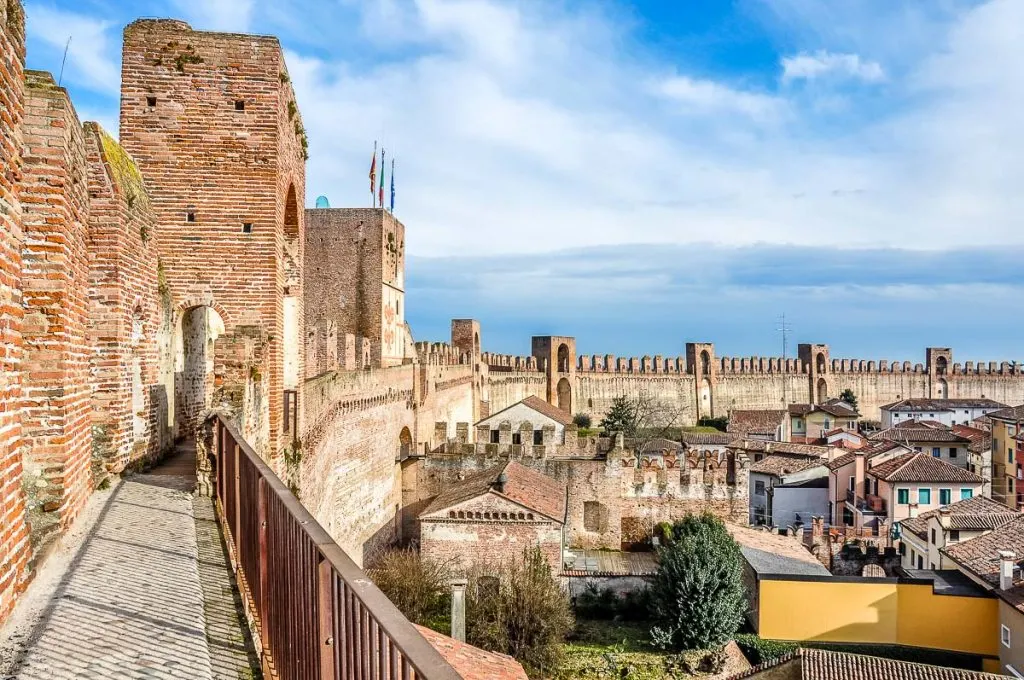
The history of the region of Veneto in Italy is rather tumultuous. The Middle Ages and the early Renaissance were particularly busy periods with several pretenders vying for dominance over the rich land. Towns circumnavigated by thick defensive walls were built in Veneto’s plains and hills to protect the local rulers’ interests.
These medieval walled towns are incredibly interesting to visit today. Easy to reach from Veneto’s main cities by either car, train, or bus, they offer an insight into the past. Expect to see proud castles, to walk along thick walls, to hear curious local stories, and even to take part in a town-wide historical reenactment or religious festival.
To give you plenty of ideas for day trips in the history of Veneto, here are my favourite medieval towns here:
Asolo – a picture-perfect hilltop place known as the Town of a Hundred Horizons and the Pearl of the Province of Treviso. Over the centuries, its beauty has attracted many artists, writers, and royals. For example, the last monarch of the Kingdom of Cyprus, Caterina Cornaro, and the travel writer Freya Stark.
Castelfranco Veneto – a gorgeous town with an impressive defensive wall, a pretty historic centre, and a host of festivals and events, including a large chocolate festival each spring. This is also the birthplace of Giorgione – one of the most famous artists of the Venetian school.
Cittadella – here you will find Europe’s best medieval parapet walkway. In simple English, this means that you can circumnavigate the whole town by walking on its medieval defensive wall. In September, don’t miss the town-wide medieval fair. In winter, a nice little ice rink is built on the central square.
Conegliano – one of the main towns in Veneto’s Prosecco Hills (see point 10) and also the birthplace of the Renaissance artist Cima da Conegliano. This is a beautiful medieval walled town with an atmospheric castle (which nowadays functions as a museum), a lovely cathedral, and the impressive fully frescoed Sala dei Battuti – the meeting hall of a religious confraternity.
Este – in the bosom of the Euganean Hills, this small walled town has a history that spans over three millennia. In the local archaeological museum, you can explore the history of ancient tribes and marvel at the intricate decoration of the Benvenuti Sittula – a bronze funerary urn from 600 BC.
A beautiful park with roses and a kids’ playground has been created where the old castle once stood. The locally produced pottery is highly prized, too. The town is a great starting point for nature hikes and is a short drive away from another beautiful medieval town – Monselice.
Feltre – huddled on top of a small hill, this medieval walled town is surrounded by the powerful peaks of the Dolomites. Tall stone houses with frescoed facades and whimsical chimneys will capture your imagination. There are several museums and churches, a lovely theatre, and a stunning main square – Piazza Maggiore. Don’t miss the 11th-century Sanctuary of St. St. Vittore and Corona nearby.
Marostica – a very pretty town with an imposing medieval wall which climbs up to the top of a steep hill. There are two castles here. One – ruined, on top of the hill. The other – beautifully preserved and standing right next to the town’s main square.
In June, the town holds several events dedicated to its cherries. They are large, juicy, and sweet and the start of summer is when they are at their best. Every other September Marostica stages a game of chess with people and horses instead of chess pieces. The performance is based on a local legend and ends with a huge fireworks display.
Montagnana – this is where some of the best Italian prosciutto is made. The town is very pretty, too. It is fully surrounded by a powerful defensive wall. There is also a castle, a lovely main square, and a stunning cathedral with a rich repository of art (including rare frescoes by Giorgione).
Serravalle (nowadays, part of Vittorio Veneto) – this small hamlet is a medieval fairytale come true. Don’t miss the Museo del Cenedese for its fabulous frescoes, paintings, and the opportunity to imbibe curious local stories. Plus, the ticket includes a visit to the fully frescoed Oratorio dei Battuti next door.
5. Veneto’s Seaside Towns and Veneto’s Tegnue
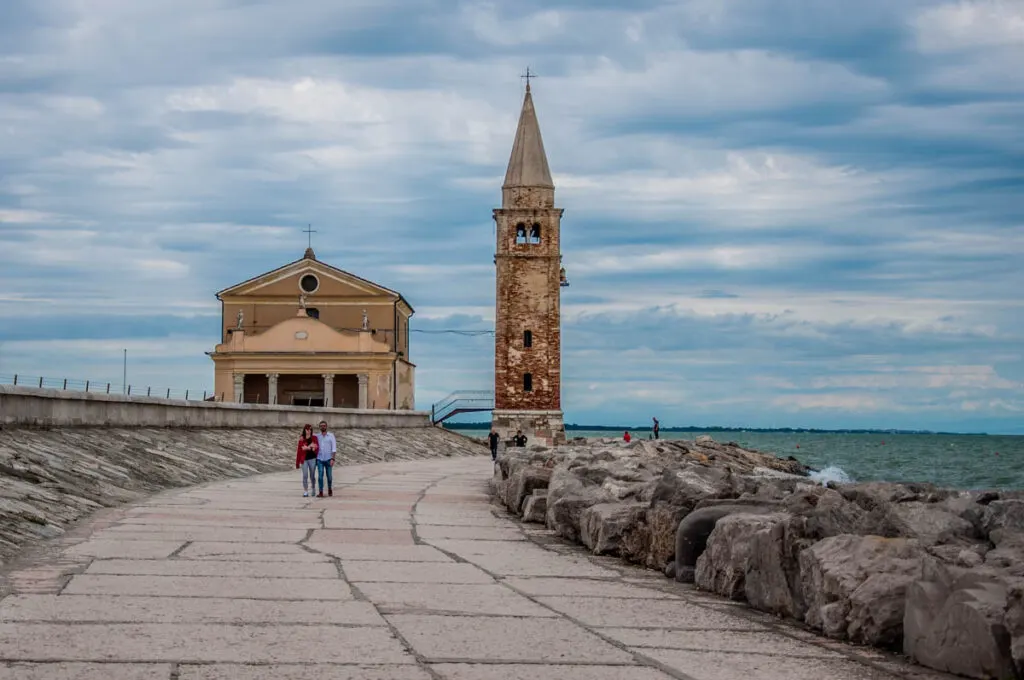
The sparkling Adriatic Sea bathes Veneto’s eastern border. This long strip of land is dotted with pretty seaside towns. With cute historic centres flanked by endless sandy beaches, they are a fantastic destination for a day trip or a long holiday of sunbathing and swimming.
Here are three of the best in terms of beach facilities, fresh seafood, and local sights. Which one are you going to put on your Veneto bucket list? Let me know in a comment below.
Caorle – this is a super cute fishing town with houses painted in bright colours. After a nice lunch of fritto misto – a mix of battered and fried pieces of fish and seafood served on a bed of polenta – go for a walk along the seaside promenade. You will see that it doubles as an open-air art gallery as artists from all over the world have carved different shapes in the large wavebreakers. At the end of the promenade stands the iconic fishermen’s Church of Madonna dell’Angelo.
Next door to Caorle you can visit the historical casoni. These are typical for the area houses made of wood and canes where the local fishermen and their families used to live. The renowned writer Ernest Hemingway described Caorle and its lagoon in his novel Across the River and into the Trees.
Chioggia – this is a town that looks a lot like Venice but it is in fact older than Venice itself. It’s built on islands on the southern tip of the Venetian Lagoon and it is connected to terra firma by a causeway. Chioggia has a wonderful atmosphere to it. There are some lovely museums, art-filled churches, two fish markets, an enormous fleet of fishing boats (one of the largest in Italy, in fact), and cute little restaurants serving delicious seafood. Plus, there are much fewer tourists!
Next to Chioggia, you can visit Sottomarina – a half-town/half-summer resort with a kilometric beach and vibrant nightlife during the high season.
Jesolo / Lido di Jesolo – one of the best destinations in Italy if you are after a beach holiday. Expect endless sandy beaches, huge water parks, beachside entertainment, and fun boat trips. Plus, Venice is just across the water if you feel like some art and culture after all that summer fun. In winter, Jesolo has a great Christmas market and a large Nativity scene made of sand.
Veneto’s Tegnue – if you love diving, you may be thrilled to find that the region of Veneto in Italy has its own ‘coral reefs’! Considered somewhat of a geological anomaly, these are areas of rocky outcrops with rich shoals of flora and fauna.
Known as Tegnue in the Venetian language, these genuine natural reefs were built by coralline algae over the past 7,000 years. Home to colourful sea sponges, anemones, sea squirts, lobsters, crabs, and fish, the reefs can be seen at a depth of 20 to 28 metres.
Centuries ago, fishermen’s nets would often get caught in the rocks of the reefs. This led to the proliferation of many local legends about an ancient civilization submerged in the Adriatic. Nowadays, large scientific studies have established the origins of the Tegnue and described its rich character as a divers’ paradise.
Bear in mind that the areas of the Tegnue are protected and diving here is strictly monitored. Local diving clubs in Chioggia and Sottomarina organise diving expeditions and there are about 11 diving sites.
6. Veneto’s Towns on Lake Garda
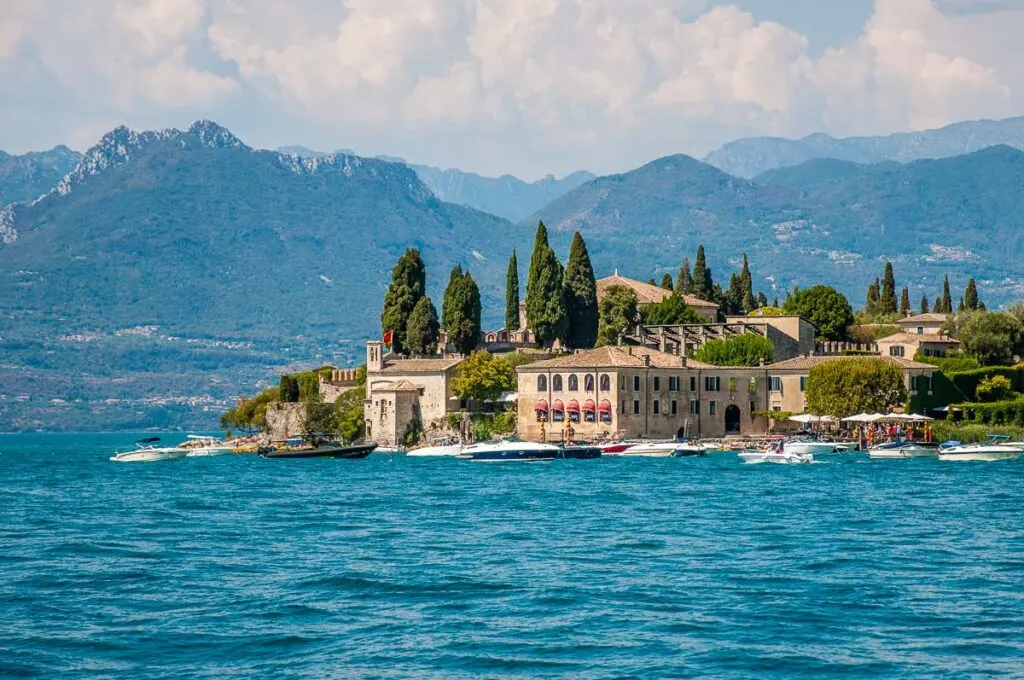
Lago di Garda is Italy’s largest lake. Its small lakefront towns and varied landscapes make it a lovely place to visit. Territorially, the lake is split between three northern Italian regions – Veneto, Lombardy, and Trentino-Alto Adige.
Veneto’s portion of Lake Garda is particularly beautiful with its olive groves, lush slopes, and cute, little beaches. Here you can hike, sail, hire a motorboat, dive, and relax. Dozens of quirky museums, historic churches, medieval villages, picturesque towns, and large theme parks fill up with excitement each visit to the Veneto’s shores of Lake Garda.
Here are some of the prettiest towns to visit here for you to take your pick from:
Lazise – this small lakefront town has a well-preserved medieval castle and a defensive wall encircling its historic centre. The old harbour is where colourful boats moor in the shadow of the 12th-century Church of San Nicolo’ and the 14th-century Venetian Customs House (Dogana Veneta). Restaurants and gelato shops are lined up along the wide promenade which passes by a small beach and then continues to the nearby town of Bardolino. In the vicinity of Lazise, you can visit some of Italy’s largest theme parks. The most popular of them is called Gardaland.
Bardolino – famous as a wine-production centre, this small town has had an eventful history. It was an independent city-state until 1193. Then it was ruled by the Scaliger dynasty from Verona, followed by the Republic of Venice, and finally by Austria before it joined Italy in 1866. Bardolino has a very cute historic centre, several churches from the 11th-12th centuries and 12th-century defensive walls. The town is charming. There is a promenade, a marina, and lots of eateries with open-air seating areas. A Christmas market with a small ice rink takes place every year.
Garda – the town of Garda gave the lake its current name. It comes from the Germanic word warda it means ‘place of observation’ or ‘guard’.
The town stretches along a small bay overlooked by a steep outcrop known as Rocca di Garda. In the early Middle Ages, a fort was built here to keep an eye on the lake and to prevent enemy attacks. Nowadays, you can hike to the top of Rocca di Garda (it takes about half an hour or so) to enjoy the splendid panoramic views over the lower half of the lake.
In the town of Garda, you will the old Captain’s Palace. It’s built in the Venetian Gothic style and in the past, it was used as a residence and office by the Captain, the local ruler appointed by the Republic of Venice. Originally, the harbour was right in front of the palace, but at a later stage, it was filled in to create the town square.
Punta di San Vigilio – five minutes away by car from the town of Garda you can visit one of the most charming spots on the lake shores. Punta di San Vigilio is a natural promontory with a lovely park, olive groves, and a medieval hamlet with a beautiful villa. Today it functions as a luxury resort.
Many famous people have stayed here, for example, the British statesman Winston Churchill and the actress Viviene Leigh. A popular tavern attracts a refined crowd here in summer. In winter, the promontory is almost deserted and it feels very special to walk around in the company of a special friend or a loved one.
Torri del Benaco – this picturesque town preserves the memory of Lake Garda’s ancient name, Lacus Benacus. A beautiful medieval castle built on Roman ruins overlooks the shell-shaped historic harbour. Converted into a museum, the castle also has an 18th-century winter garden – known as limonaia – where citrus trees grow next to a fish pond.
Malcesine – for me, this is the prettiest town on Lake Garda. It stands in the foothills of Monte Baldo, a mountain range where you can ski in winter and hike in summer. Rare plants, including several varieties of orchids, grow here. A cable car with a swivelling cabin will take you from Malcesine to the mountaintop in a few minutes. It is a great experience with fantastic panoramic views.
In Malcesine, don’t miss the medieval castle, the hidden beach, and the historic centre with its steep cobbled streets and traditional harbour. Up to around a century ago, the town could only be reached by water. Nowadays, Malcesine is on the road that circumnavigates the whole lake connecting the small towns on its shores.
7. Veneto’s Spa Towns and Resorts
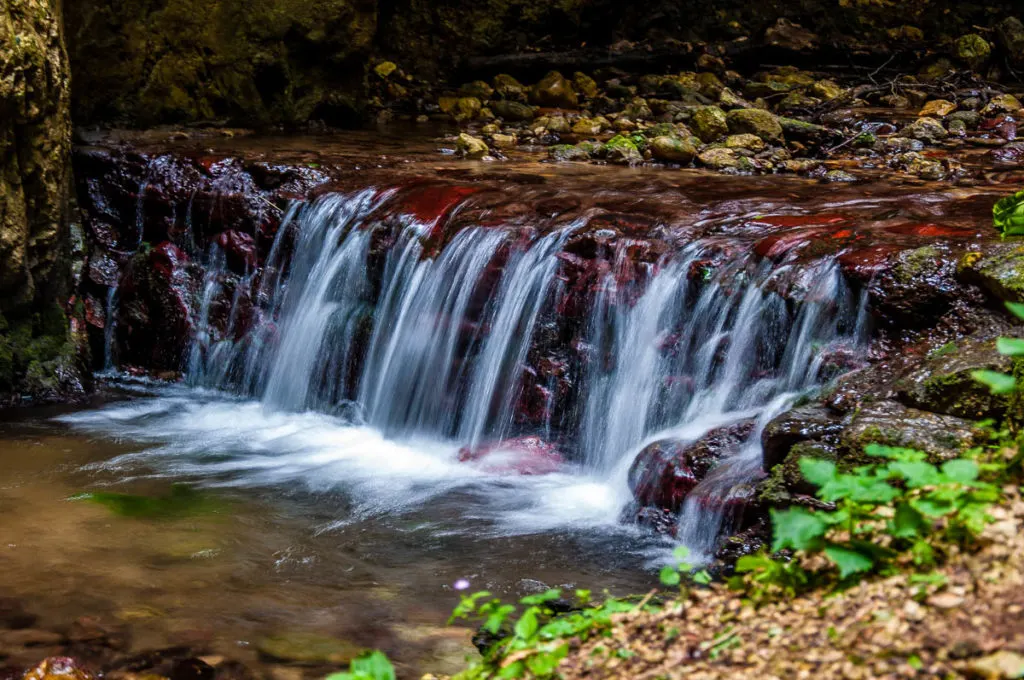
There are many mineral water springs across the territory of Veneto. Making use of their medicinal properties, spa towns and spa resorts have been built all over this northeastern Italian region.
A mini spa break is a great way to spend a few hours or a couple of days here. It’s both relaxing and revitalising and it gives you a chance to experience Italy beyond the traditional art, history, and food trail.
Here are some spa destinations to consider:
Spa Centres and Spa Hotels in Veneto: A special mention deserve Aquardens near Verona, Aqualux Hotel Spa Suite & Terme in Bardolino, Garda Thermal Park near Lazise, and Hotel Ai Reali in Venice.
Spa Towns in Veneto: Abano Terme and Montegrotto Terme are two towns in the Euganean Hills which are completely dedicated to the culture of spa. Hundreds of hotels and spa facilities offer all sorts of treatments and access to thermal swimming pools. You will be spoilt for choice. Both towns are easy to reach from Padua, Venice, and Vicenza.
Bibione is a lively seaside resort just up from Venice. Here you will find large spa facilities overlooking the sandy Adriatic beaches thus offering the full package of summer fun and relaxation.
Recoaro Terme is a somewhat faded beauty of a town and once a popular spa resort. People have been coming here for centuries to take the waters in search of cures for body, soul and mind.
8. Veneto’s Islands
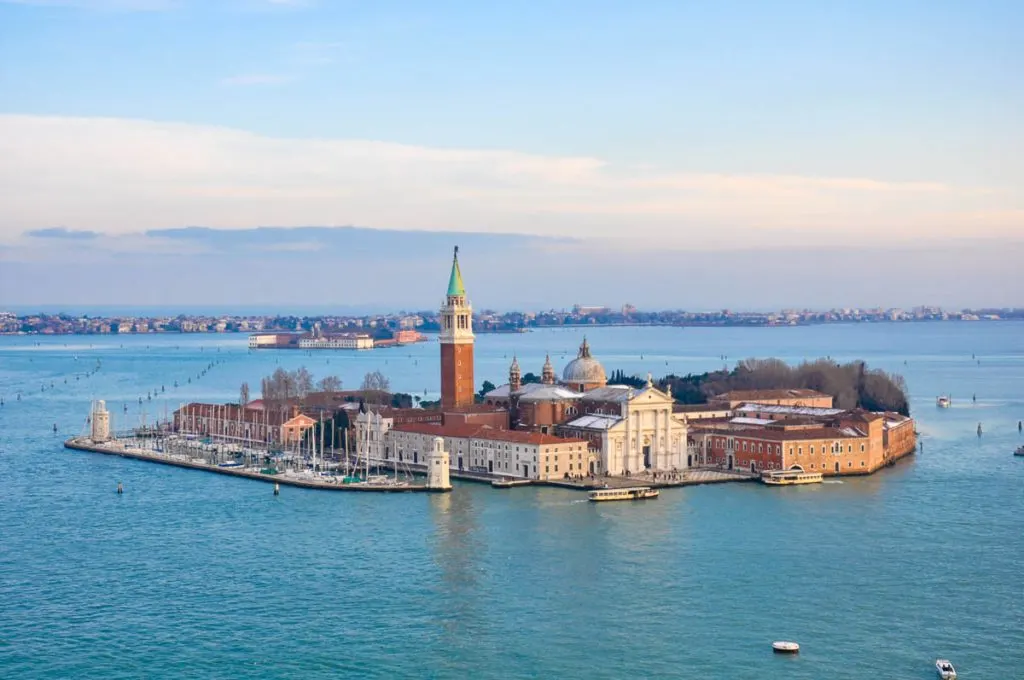
A curious fact about Italy is that it has so many islands and archipelagos that 1/6 of its territory is insular!
Many of them are part of the region of Veneto. There are hundreds of beautiful islands here. The most well-known example is Venice which is built on 118 islands connected by 400 bridges and separated by 170 canals.
Chioggia is another town in the Venetian Lagoon which is built on small islands. Yet, this is not all. Here are a few of the most interesting islands in Veneto that you cannot miss:
San Giorgio Maggiore – this small island is a must-see. You will spot it right across the water from the Doge’s Palace. It has a large church with a glorious Palladian facade which features in some of the most iconic photos of Venice.
A short ride by vaporetto away, the island is very easy to reach. Spend some time there exploring the church, then take the lift to the top of its bell tower to drink in the enchanting views of the City of Canals. On a bright day, you can spot the Dolomites on the horizon.
Burano – this is one of the most famous islands in the Venetian Lagoon. It is known for its lace-making traditions and fishing heritage but above all, for its houses which are painted in intensely bright colours. The local legend says that this was done so that the fishermen could spot their homes from afar even on a foggy day.
When in Burano, try the local risotto di gò which is prepared with the grass goby fish from the lagoon. Finish your meal with tasty biscuits known as bussolà and essi buranelli. I love them dipped in coffee but traditionally people dip them in marsala which is a fortified wine from Sicily.
Murano – a beautiful island to explore just a short trip by boat from Venice. This is where the art of modern glassmaking took shape several centuries ago. Many glassmaking artists and studios operate on the island. You can see a glassmaking demonstration, shop for unique pieces of glass, and admire the stunning Murano glass chandeliers.
The Murano Glass Museum is also well worth a visit. Next to it, don’t miss the Santa Maria and San Donato Church. It has lovely Byzantine mosaics and right behind the altar, you may spot some large bones which the local legend says were from the dragon slain by St. Donatus.
Torcello – this was the first island to be permanently settled in the Venetian Lagoon. You will see it just off the coast of Burano. In the early Middle Ages, a few thousand people lived and traded here. Later on, due to changes in the ecology of the lagoon and enemy incursions, most of Torcello’s population moved to the islands of Burano and Murano and then they settled on the islands which nowadays we know as Venice.
Only a handful of people still live on Torcello but the island has important historic buildings. Among them is the Church of Santa Maria Assunta with some of the most beautiful and best-preserved Byzantine mosaics in Europe.
Also here you can see one of the last two bridges with no railings in the whole of the Venetian Lagoon. It’s known as Devil’s Bridge and has dark legends associated with it.
N.B.: You can easily visit Murano, Burano, and Torcello on the same day either by buying a pass for the network of water buses (called vaporetti) in the lagoon or by booking an organised tour. This one is very popular. Or you can see what other options are available by clicking here.
Lido di Venezia – this is a thin and long sandbar with beaches, hotels, and resorts. Here you will also find the only golf course in Venice. The island is less than 20 minutes away by vaporetto from St. Mark’s Square.
Lido is where the Venice Film Festival takes place in September every year. You can actually drive here – something which is not possible in the fully pedestrian Venice. There is a car ferry which connects the Italian mainland to the island of Lido di Venezia.
Pellestrina – this is a long and thin island between Chioggia and Lido di Venezia. It is seldom visited by tourists. It is known for its colourful houses and its lace, as well as for its murazzi wall. This is an impressive embankment built of Istrian stone by the Republic of Venice to defend the banks of the lagoon from sea erosion.
San Servolo – this is a little-known islet just off Venice. It was first inhabited by Benedictine monks and then a military hospital was built here. Later the hospital was used to treat people with mental illnesses. Nowadays it functions as a sensitively curated museum.
Isola Albarella, Isola Donzella, and Isola di Ariano – these are small islands in the Delta of the river Po. Here you can stay in modern resorts with golf courses in the bosom of nature. Flocks of pink flamingoes live in the marshes nearby.
Islands in Lake Garda – there are several small islands in Lake Garda. Isola del Garda is the most well-known one. This is a private island with a palatial villa surrounded by Italian and English gardens. Guided visits are organised seasonally. Alternatively, you can book a boat tour taking you past a couple of the small islands here and allowing you to enjoy the beauty of the lake shores from the water.
9. Veneto’s Parks and Gardens
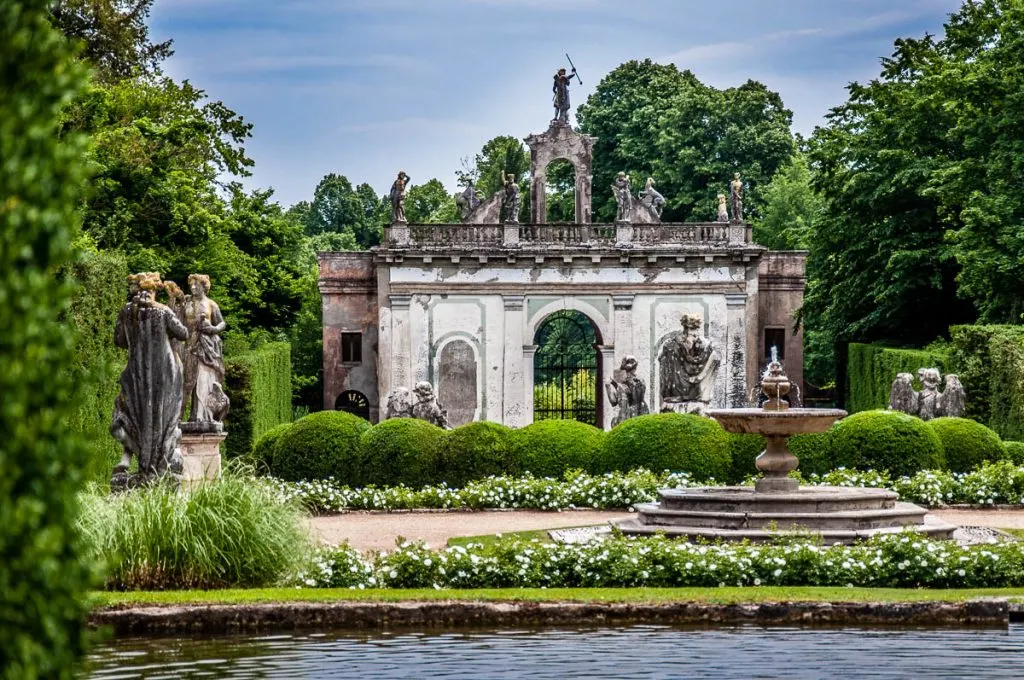
The region of Veneto is also well-known in Italy for its lovely gardens, landscaped parks, and general abundance of lush, green spaces.
Many palaces and villas here have expansive historic parks which are open for visits. They are a great place to spend a couple of hours or even a whole day just relaxing and enjoying the seasonal blooms. In some, you can even take in a picnic to tuck into while sitting on soft grass surrounded by family, friends, and many carefully cultivated native and exotic trees and plants.
Here are some of the most beautiful parks and gardens to visit in Veneto yourself. Many of them are award-winning and were originally planted several centuries ago. Be aware that due to seasonal closures, you may not be able to visit some of the gardens below during the low season. Check their websites for their specific opening hours.
Monumental Garden of Valsanzibio – this historic garden is on the outskirts of the small town of Galzignano Terme in the Euganean Hills. It’s easy to reach from Padua and it’s well-known for its 400-year-old maze, Baroque designs, and whimsical features like its water cascades and trick fountains. They say that the Monumental Garden of Valsanzibio was one of the inspirations for the gardens of Versailles in France.
Parco Giardino Sigurtà – this is one of Italy’s most important and most beautiful landscaped parks. It stands in the small town of Valeggio sul Mincio which is next door to Verona and Lake Garda.
Over the years, Parco Giardino Sigurtà has been named the Most Beautiful Garden of Italy, has won awards for its stunning tulip displays, and in 2015 it took second place at the European Garden Awards. The park was first planted several centuries ago. In 1941 it was acquired by the Sigurtà family.
There are many things to see and enjoy here on a long sunny day – gorgeous spring flower displays (including one million tulips), wide green spaces which are perfect for picnics on lazy afternoons, picturesque ponds with huge koi carps, a rose avenue, a maze, a sundial dedicated to Romeo and Juliet, a medicinal herb garden, and water gardens, too.
Villa Parco Bolasco – this lovely 19th-century garden was chosen as Italy’s most beautiful park for 2018. You will find it just off the historic centre of the medieval walled town of Castelfranco Veneto (see point 4 above). Its most impressive feature is the circular horse-riding arena surrounded by 52 statues.
Botanical Garden of Padua University – this is the oldest academic botanical garden in the world. It is also a UNESCO World Heritage Site. Here history and plants have created a beautiful, intriguing place where you can spend a few happy and relaxing hours.
The historic enclosed garden preserves its layout just as it was back in the first half of the 16th century. The new Biodiversity Garden is housed in a modern glasshouse where you can walk through the world’s different climate zones. The botanical garden is in the historic centre of Padua and you can easily see it as part of a day trip to this beautiful city in Veneto.
Gardens of Villa Pisani – known as the Queen of the Venetian villas, Villa Pisani is in the small town of Stra just outside of Padua. It has a gorgeous park with Italian and English gardens, several large water features, an icehouse, and a maze. This is a great place to spend a hot summer day. The villa itself is absolutely beautiful (see point 15 for more details).
Butterfly Ark and Forest of the Fairies – the oldest butterfly house in Italy is in the small spa town of Montegrotto Terme next door to Padua. Here you can see hundreds of gorgeous specimens from Africa, Asia and the Amazon fluttering freely among native flowers, trees, and bushes.
Once you have walked through the marquees housing the butterflies, you will find yourself in a lovely park of 6,000 sq m. Called Bosco delle Fate (in English the Forest of the Fairies), you can follow its winding paths glimpsing along the way all sorts of weird and wonderful creatures.
Large posters in both English, Italian, and German give in-depth information about witches, fairies, ogres, and trolls. It is all good fun and a great place to take the kids to fire up their imaginations.
Giardino Giusti – for stunning views of fair Verona, head to the lovely Giusti Garden. You will find it on the opposite side of the river Adige, just a short walk away from the city’s historic centre.
This Renaissance garden, first planted in the 15th century, is a place of contrasts. It has a flat part which has been styled in the best Italian gardening traditions and then, suddenly, it rises sharply up a steep hill all the way to Verona’s medieval defensive walls.
Tall cypress trees flank the alleys which are dotted with statues and turtle-populated fountains. The Giusti Garden made a huge impression on the German writer and statesman Goethe when he visited Verona in 1786.
10. Veneto’s Prosecco Hills
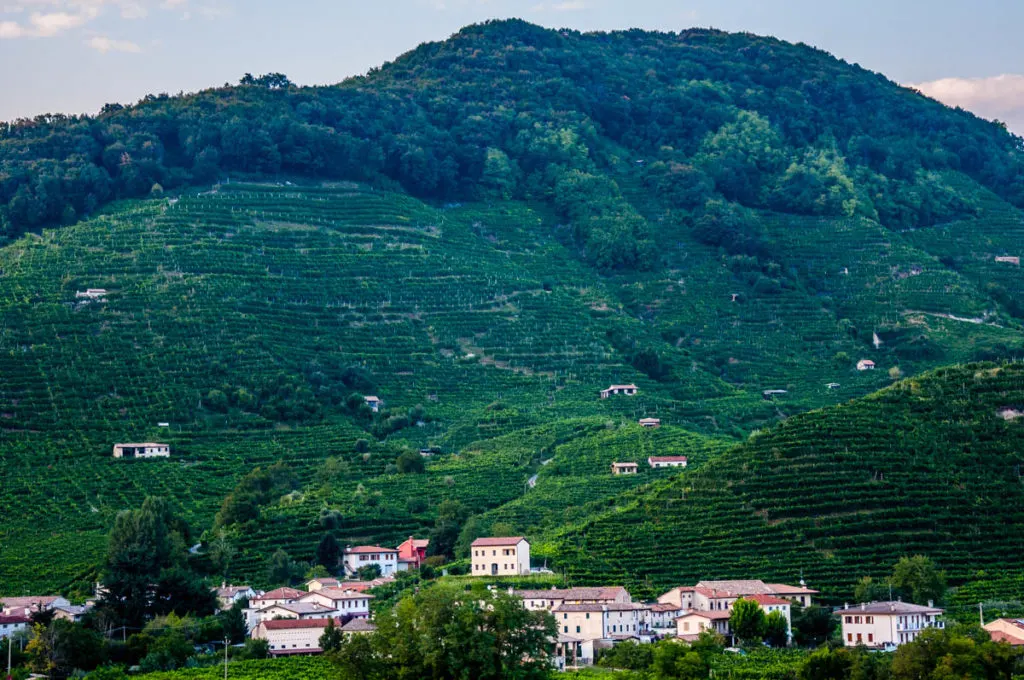
Prosecco is the Italian sparkling wine that has become the staple of every brunch and party in the last few years. The main area where it is made is known in English as the Prosecco Hills or Colline del Prosecco di Conegliano e Valdobbiadene in Italian. You will find it between the small towns of Conegliano and Valdobbiadene in the region of Veneto.
This is an enchanting destination of rolling hills carpeted with endless vineyards. In 2019, it became a UNESCO World Heritage Site.
You can easily reach Conegliano by train from Venice, Treviso, and Padua. This medieval walled town is worth a day trip in itself. The onward exploration of the nearby vineyards and wineries is best done by car. You can either rent one or book an organised tour either locally or directly from one of the main cities in Veneto. For example, this is the best-recommended tour of the Prosecco Hills straight from Venice.
The Prosecco Hills are dotted with medieval castles, fast rivers and small lakes, old abbeys and churches with precious works of art, and even an old mill next to a picturesque waterfall (Molinetto della Croda). It is a beautiful, tranquil area where you can truly relax and immerse yourself in the authentic Italian lifestyle.
11. Veneto’s Lakes and Rivers
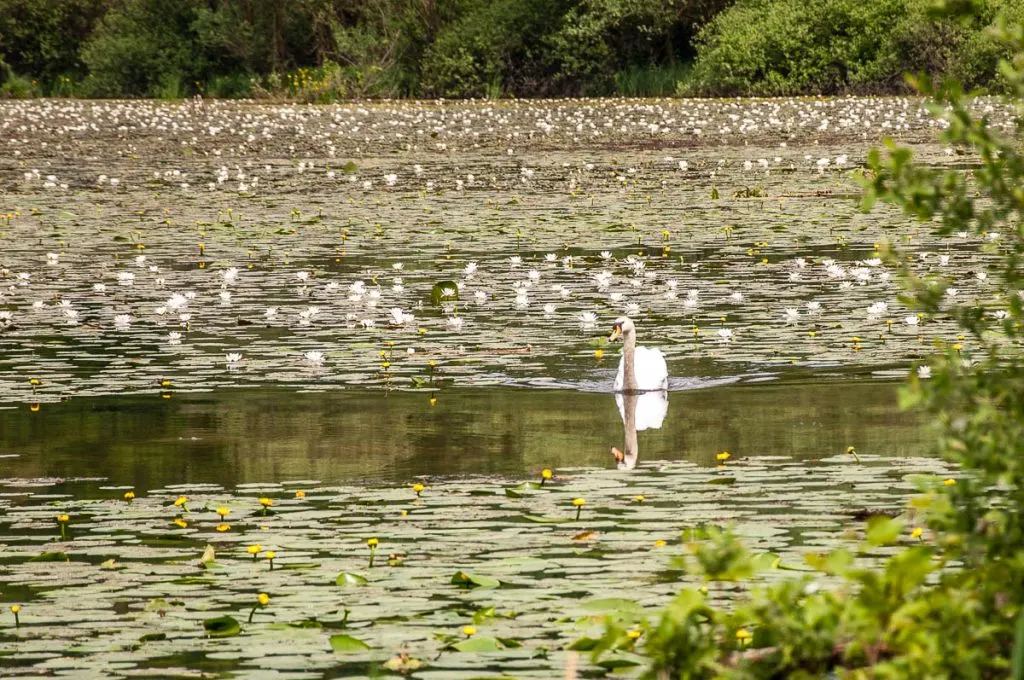
There are many beautiful lakes and rivers in the region of Veneto in Italy. You will love exploring them if you want to feel close to nature, enjoy breathtaking views, practise water sports, and even take a refreshing dip in the heat of summer. While Lake Garda (see point 6 above) is the most well-known of them all, there are many more water bodies here that are worth a visit.
Here are a few suggestions:
Lakes in Veneto – you will find many lakes in the region’s mountainous areas. In the Province of Belluno, alone, you can enjoy the beauty of Lago di Misurina, Lago del Mis, and Lago di Aleghe. Some lakes here like Lago di Sorapis are reachable only on foot and bathing in them is prohibited. Lago di Santa Croce, on the other hand, is easy to drive to and has great beaches and water sports facilities.
In the Province of Vicenza, you can enjoy a walk around Lago di Fimon – the oldest lake in Northern Italy. At 35,000 years of age, it precedes the formation of Lago di Garda. In the Euganean Hills (see point 12 below) you will also find several tiny picturesque lakes. For example, Lago della Costa which is next door to the village of Arqua’ Petrarca. At both Fimon and Costa, archaeological excavations have revealed vestiges of prehistoric human settlements.
Rivers in Veneto – some of Italy’s largest and most important rivers flow through the territory of this northeastern Italian region. In fact, many of Veneto’s cities and towns are crossed by at least one river. For example, the River Adige in Verona, the crystal-clear River Brenta in Bassano del Grappa, the River Bacchiglione in Padua, and the Rivers Retrone and Bacchiglione in Vicenza. Treviso’s historic centre is crisscrossed by several cagnani – long wide canals fed by the waters of the River Botteniga.
Also here, you can see the River Po and its majestic delta. Po is the longest river in Italy, it flows into the Adriatic Sea and it serves as a natural border between Veneto and the adjacent northern Italian region of Emilia-Romagna.
12. Veneto’s Hills and Mountains
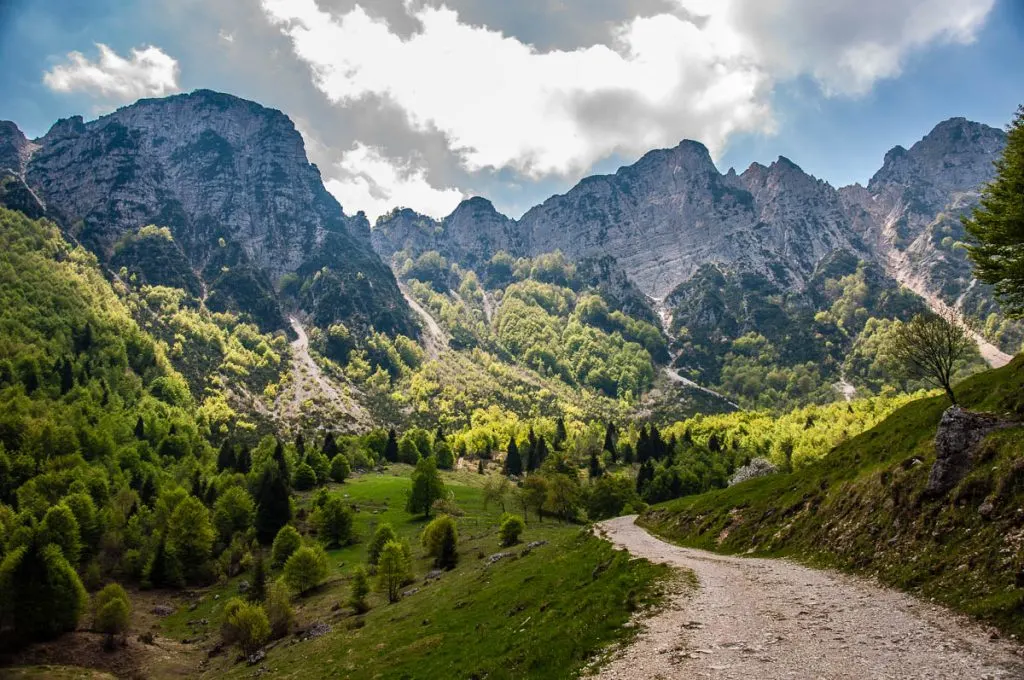
The Italian region of Veneto is dotted with beautiful groups of hills. Its northern part is where you will find majestic mountains and craggy peaks. It is a beautiful area to explore with hundreds of hiking paths for all abilities, breathtaking views over the world below, and centuries-old villages preserving curious local traditions.
In winter, you can ski, snowshoe, and relax in the saunas of luxury mountain huts. In summer, the hills and mountains here hide wildflower meadows and lush forests. It is the best place to go if you need peace and quiet to feel re-energised through daily contact with nature.
Here are the best places to head to:
Hills and Hilly Groups in Veneto: The Colli Berici flank the city of Vicenza. The Colli Euganei are next door to Padua. The Colli Asolani are easy to reach from Treviso. Carpeted with vineyards, olive groves, and cherry trees, these groups of hills are crisscrossed by hiking paths, centuries-old villages, and medieval walled towns.
The Colli Euganei (known as Euganean Hills in English) are also rich in thermal springs, so you will find some of Italy’s most famous spa resorts here (see point 7 above).
Mountains in Veneto: The city of Belluno is the gateway to the Dolomites. It is a staggeringly beautiful area with lots to do – from easy hikes to spots of natural beauty to taxing via ferrata routes giving you a chance to see the world from above. See some examples in these blog posts: Cadine del Brenton and Soffia Waterfalls, Grotta Azzurra di Mel.
The Little Dolomites is a lesser-known mountain range part of which is in the Province of Vicenza. Have a look at this family-friendly hike for an easy introduction to the beauty of the area.
The Asiago Plateau is a flat-top mountain which is a short drive away from Veneto’s plain. It has several ski resorts and it’s one of the best places to hike in the region. It was an important battleground during the two World Wars, so here you can visit old bunkers and forts. The area is also famous for the locally produced Asiago cheese and a type of smoked and aged ham called speck.
The Venetian Pre-Alps include several stunning peaks as well as some smaller mountains and massifs spread between Verona, Vicenza, Treviso, and Belluno. Two of the most well-known ones are Monte Baldo which flanks the eastern shore of Lake Garda and Monte Grappa which was the stage of important battles during the two World Wars. Nowadays a large memorial and an ossuary there keep the memory of the fallen soldiers.
13. Veneto’s Nature Reserves and Oases
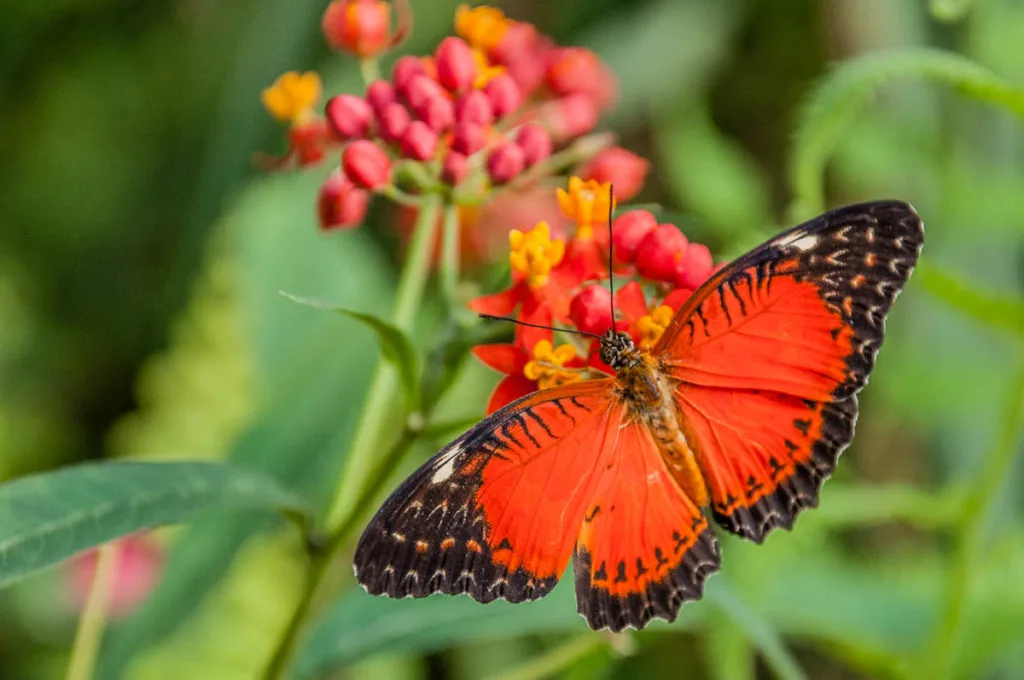
If you love getting close to nature, the region of Veneto in Italy has a lot of spots for you to explore and enjoy. All over this northeastern Italian region, you will find a large number of reserves and oases where you can birdwatch, observe the local wildlife, and spot rare plants including dozens of varieties of orchids.
The World Wildlife Fund has established several natural oases all over Veneto covering in total 445 hectares of protected land. There are also several other nature reserves run by other organisations and local volunteers. Many of these are right next to Veneto’s cities and towns and you can easily visit them on foot or by taking a local bus.
Oasi Stagni di Casale is a case in point. You will find it just outside the city of Vicenza. It is a beautiful and quiet place where you can follow the wooden walkways set above large ponds where rare birds nest. Near Treviso, you can visit Oasi di Cervara and in the Venetian Lagoon, you can spend time in the Oasi di San Nicolò and the Oasi Dune degli Alberoni. Both are on the island of Lido di Venezia – a short ride away by vaporetto (Venice’s water buses) from St. Mark’s Square. On the nearby island of Pellestrina, you can also visit the nature reserve Ca’ Roman where there is also a wild beach popular with Venetians.
I also really like Oasi Rossi (no relation to me!) near the small town of Santorso in Veneto. It is much more landscaped compared to the wild oases recommended above but it’s great to visit with kids as there is a huge playground and a cool butterfly house. As part of the visit, you can also explore the garden of a historic Venetian villa.
And, finally, make sure that you visit Veneto’s Regional Park of the Delta of the River Po. This is a huge expanse of protected land, marshes and water where you can see pink flamingoes in the wild, hundreds of other species of birds as well as several animals, river- and sea-life, and a rich variety of vegetation.
14. Veneto’s Christian Sanctuaries
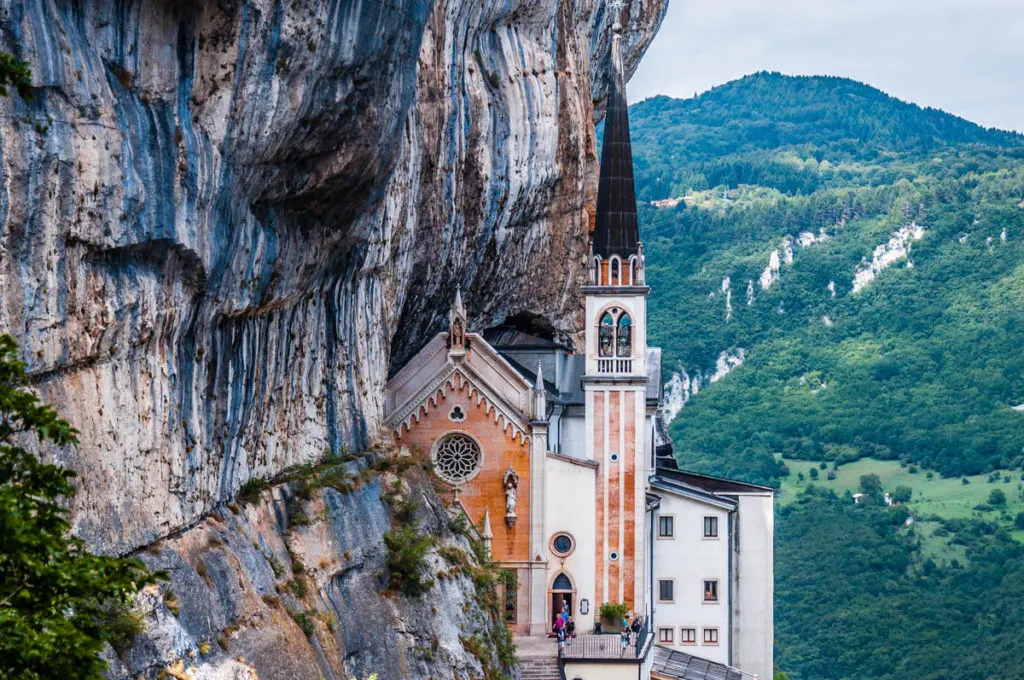
Veneto’s Christian heritage is an integral part of the spirit and the history of this northeastern Italian region. Its landscape is dotted with churches and sanctuaries. Imposing cathedrals stand in the heart of Veneto’s cities. Small chapels huddle amid villages, on the side of the road, and even deep in the forests.
Many of the religious buildings here are decorated with frescoes and paintings by renowned artists of the calibre of Giorgione (for ex., Duomo in Montagnana and the Cathedral of San Liberale in Castelfranco Veneto), Titian (for ex., Basilica dei Frari in Venice), and Andrea Mantegna (for ex., Olivetari Chapel in the Church of the Eremitani in Padua).
Religious feast days are zealously celebrated and often large-scale commemorations are held in homage to a locally revered saint or in thanks for a divine intercession.
When you explore the cities and towns of Veneto, most probably you will visit several churches guided by an interest in history, architecture, and art and/or by your religious fervour. If you want to delve deeper into this particular field of interest, make sure that you also visit at least one of Veneto’s religious sanctuaries.
Here are six of the most well-known ones:
Sanctuary of the Madonna della Corona, Spiazzi – this is the famous church that is partially hewn in the rocks of a steep mountain. Click on the link for a detailed travel guide about how to visit and what to see there.
Basilica of St. Anthony of Padua, Padua – St. Anthony is highly venerated here and millions of pilgrims flock to Padua each year to venerate his relics. The Basilica where they are preserved is a stunning work of art and devotion.
Sanctuary of St. Mary of Mount Berico, Vicenza – this minor basilica is one of Italy’s most important shrines dedicated to the devotion of the Virgin Mary. It is built on top of the hill where the Virgin appeared twice in the first half of the 15th century in order to save Vicenza from devastating bouts of the plague.
Sanctuary of Madonna del Frassino, near Peschiera del Garda – this sanctuary stands on the spot of a miraculous event that took place on 11th May 1510. This is when the local farmer Bartolomeo Broglia was attacked by a large poisonous snake as he was walking across the countryside.
He prayed to the Virgin Mary to save him. At that moment a small statue of the Madonna appeared illuminated by a strong beam of light in the branches of a nearby ash tree (in Italian, frassino) and the snake slid away. The small statue and the trunk of the tree can be seen to this day in the church built to commemorate the divine miracle.
Sanctuary of Sts. Victor and Corona, near Feltre – this beautiful sanctuary stands in a secluded hilly place a short drive away from the small town of Feltre. It was founded in the 11th century and has a beautiful cycle of frescoes. Well worth a stop if you are in the area!
Sanctuary of St. Augusta, Serravalle – this small hilltop sanctuary overlooks the beautiful medieval hamlet of Serravalle (nowadays part of the town of Vittorio Veneto). It can be reached on foot by scaling a long stone staircase that starts from the bottom of the hill. The chapel is built at the spot where the daughter of the local feudal, Augusta, was martyred in the 5th century for refusing to renounce her Christian faith.
15. Veneto’s Venetian Villas
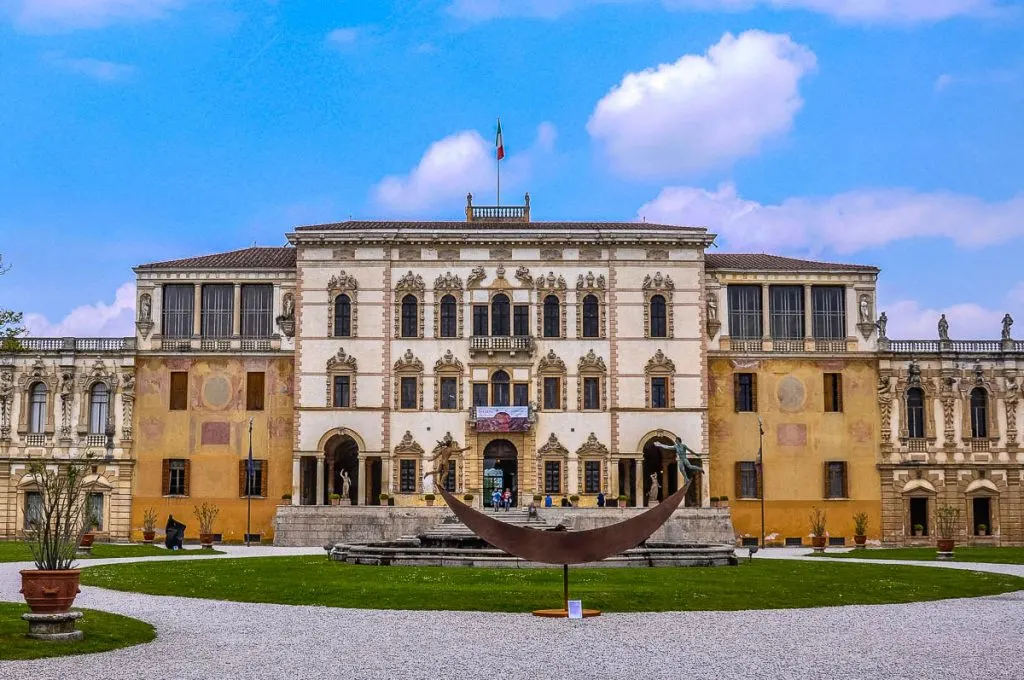
The region of Veneto in Italy is dotted with elegant historic villas which in the past served as seasonal residences to rich landowners from Venice, Padua, and Verona. They would spend the summer in these country homes overseeing agricultural activities and harvests while their families enjoyed country living in utmost comfort.
Designed and frescoed by famous architects and painters of the Renaissance and the Baroque era, the Venetian villas were surrounded by vast agrarian estates. Nowadays, many of them are open for tourist visits allowing you to get a glimpse into an expired world of summer sophistication.
There are dozens of villas all over Veneto and many are still in private hands. Several of them were designed by Andrea Palladio – the famous Renaissance architect who originated the Palladian style. Others are entirely frescoed by the likes of Veronese and Tiepolo and exhibit exquisite collections of fine and decorative arts.
Here are six of the most famous Venetian villas. They are also easy to visit from the nearest large city in Veneto and make for a wonderful half- or full-day trip in this corner of Italy:
Villa Capra La Rotonda + Villa Valmarana ai Nani, Vicenza – Villa Capra La Rotonda is Palladio’s most famous villa. It crowns the top of a small hill and has four identical facades. Its design was inspired by classical temples and over the centuries it was used to inform the architecture of several important buildings all over the world including the White House in Washington D.C.
You will find it on the outskirts of Vicenza and can easily walk to it in half an hour or so from the city’s train station. Combine it with a visit to the Villa Valmarana ai Nani which is right next door. Here you can admire the mythological frescoes by father and son Giambattista and Domenico Tiepolo. There is also a splendid garden and a lovely cafe overlooking the nearby hill of Monte Berico.
Villa Contarini, Piazzola sul Brenta – absolutely splendid, this villa looks more like the royal palace of a small country. It is a place where many lively events are regularly held, including a monthly antique and vintage market which is one of the largest of its kind in Italy.
Villa Foscari La Malcontenta, Mira – a beautiful Palladian villa with an imposing facade. Its rooms are decorated with a large cycle of frescoes which follow a carefully designed iconographical programme.
Villa Pisani, Stra – traditionally called the Queen of the Venetian Villas, this is an enormous building with an even bigger garden behind it. It has a fascinating history, a series of rooms covered with frescoes, an especially resplendent ballroom, a maze, and impressive water features. A must-see!
The small town of Stra is right next door to Padua. Once there, you can also visit Villa Foscarini Rossi. It stands just up the road from Villa Pisani and it houses a large Shoe Museum.
Essential Travel Guide for the Region of Veneto in Italy
Pin for Later!
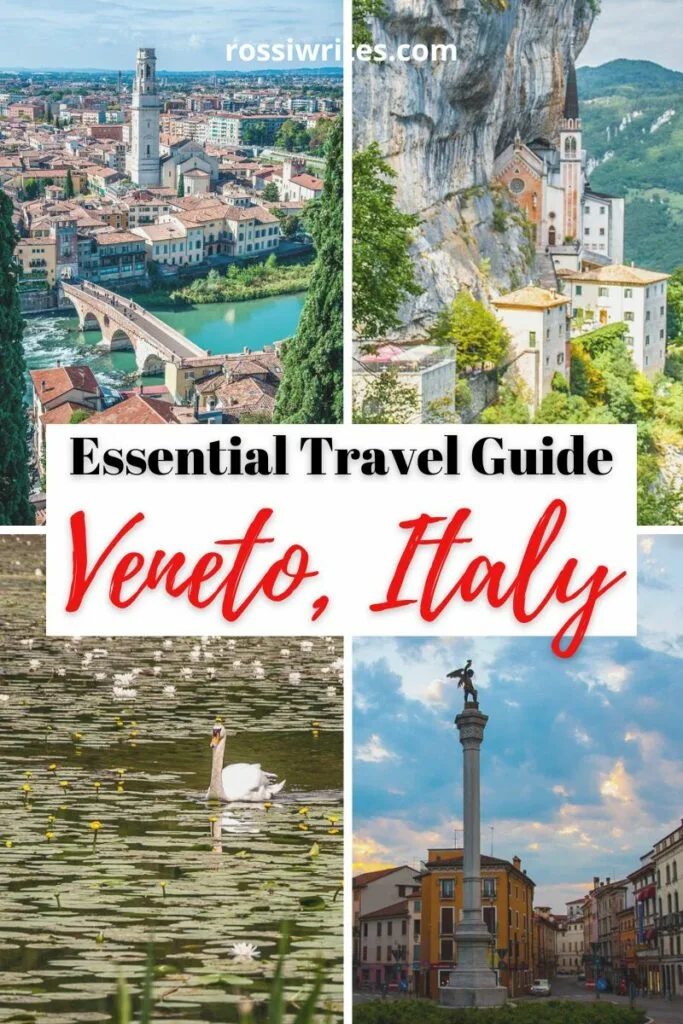
Is Veneto Worth a Visit?
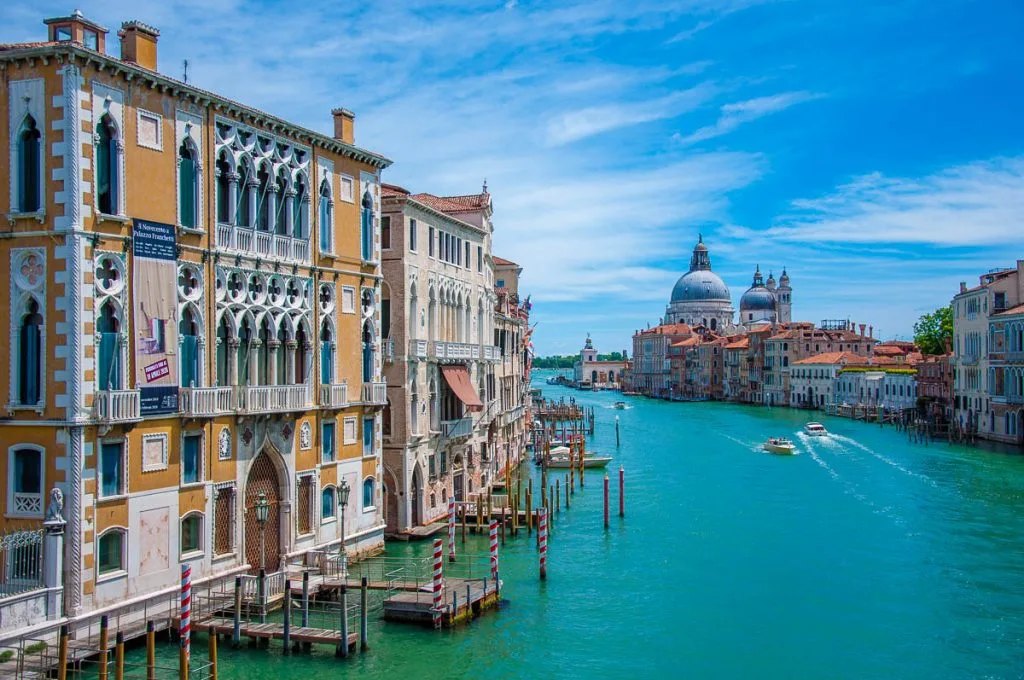
The region of Veneto in Italy is a must-see destination on account of its history, artistic heritage, and pristine nature. Flanked by the Adriatic Sea, the Dolomites, Lake Garda, and the Delta of the River Po, this is a place with a varied landscape studded with cities of art, walled towns, and picturesque villages.
Captained by its capital – the famous city of Venice – Veneto has a lot to offer to the person seeking memorable travel experiences. Expect beautiful surroundings and wonderful galleries and museums, excellent beaches and countless opportunities for sightseeing and keeping active.
A short flight away from most major European cities and easy to get around by road and railway, Veneto is a delight to explore. In this blog post, you will find lots of information about the top places and the best destinations to see here.
Is Veneto the Same as Venice?
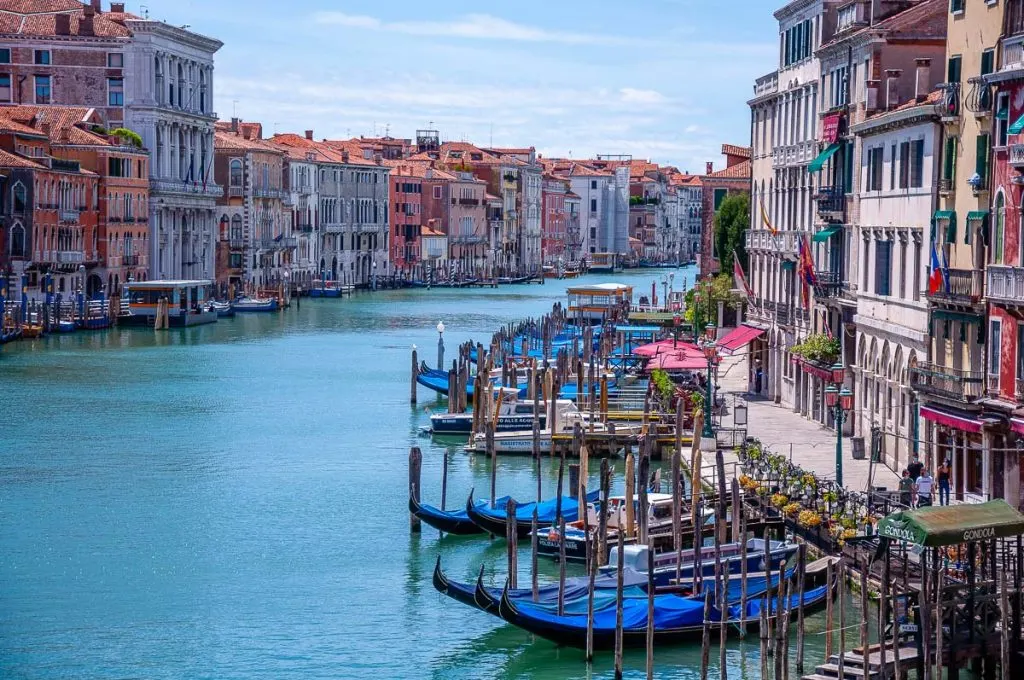
Veneto is one of Italy’s twenty regions. Venice (or Venezia) is its capital city. The English adjective for both Veneto and Venice is Venetian which sometimes may create the confusion that both are the same place. In Italian, there are two distinct adjectives:
- veneto (m) / veneta (f) for Veneto; and
- veneziano (m) / veneziana for Venezia.
In the past, Venice used to be a powerful republic (also known as La Serenissima) which exerted its commercial and political influence all over the Mediterranean and also ruled over vast swathes of land in what nowadays is Northern Italy.
Nowadays, Veneto’s territory corresponds to a large percentage of this historic dominion although several portions of it are part of the adjacent Italian regions. For example, the city of Bergamo (the historic centre of which is still surrounded by mighty Venetian walls) is part of Lombardy and the city of Udine (with its Venetian buildings and atmosphere) is part of the region of Friuli Venezia Giulia.
How to Get to the region of Veneto in Italy?
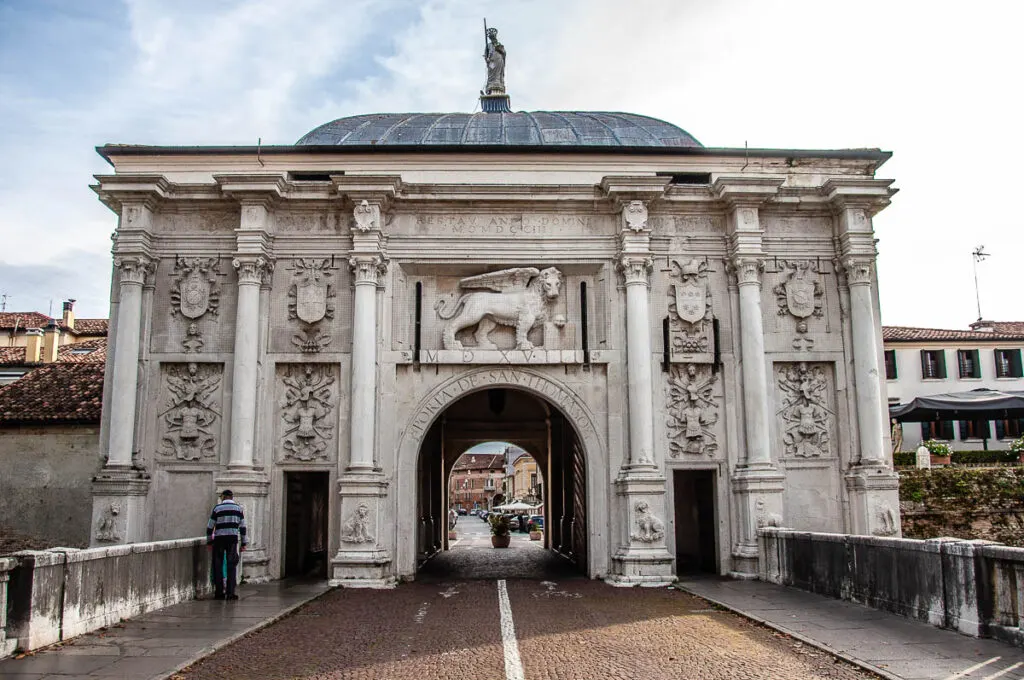
Veneto has three main international airports:
- Venice Marco Polo Airport;
- Treviso Antonio Canova Airport; and
- Verona Valerio Catullo Airport (also known as Verona Villafranca Airport)
This northeastern Italian region is also easy to reach from the following major airports in Northern Italy:
- Bergamo Orio al Serio Airport;
- Trieste – Friuli Venezia Giulia Airport;
- Bologna Guglielmo Marconi Airport;
- Milan Malpensa Airport.
For more information, have a look at these blog posts:
Best Airports: in Northern Italy, for Venice, for Verona, for Lake Garda
Veneto is also easy to reach by car. High-speed toll roads connect the region to the rest of Italy and Europe. Of these, the most important ones are:
- A4 (known as La Serenissima) – it connects the cities of Turin and Trieste and it passes by Verona, Vicenza, Padua, Venice, and Treviso.
- A22 (known as Autostrada del Brennero) – it connects the northern Italian region of Emilia-Romagna to Austria and it passes by Verona and Lake Garda.
- A13 (known as Autostrada Euganea) – it connects the cities of Bologna in Emilia-Romagna and Padua in Veneto and it passes also by the city of Rovigo.
International and national trains connect Veneto to the rest of Europe and Italy. For example, you can get direct trains (some of them with sleeper compartments) from Austria and France to Venice. High-speed (Frecciarossa, Frecciabianca, Frecciargento, and ItaloTreno) and fast regional trains (treno regionale veloce) link Veneto’s cities to other major cities and smaller towns all over Italy.
It’s always best to buy your tickets for the high-speed trains well in advance, otherwise they may increase closer to the day of departure. Regional trains usually maintain a stable price and tickets for them can easily be bought on the day. Just make sure that you validate them by using one of the machines that are dotted all around Italian train stations.
To check train times and book train tickets in advance, I find the following three websites very useful: Omio, ItaloTreno, and TrenItalia.
How to Travel Around the Region of Veneto in Italy?
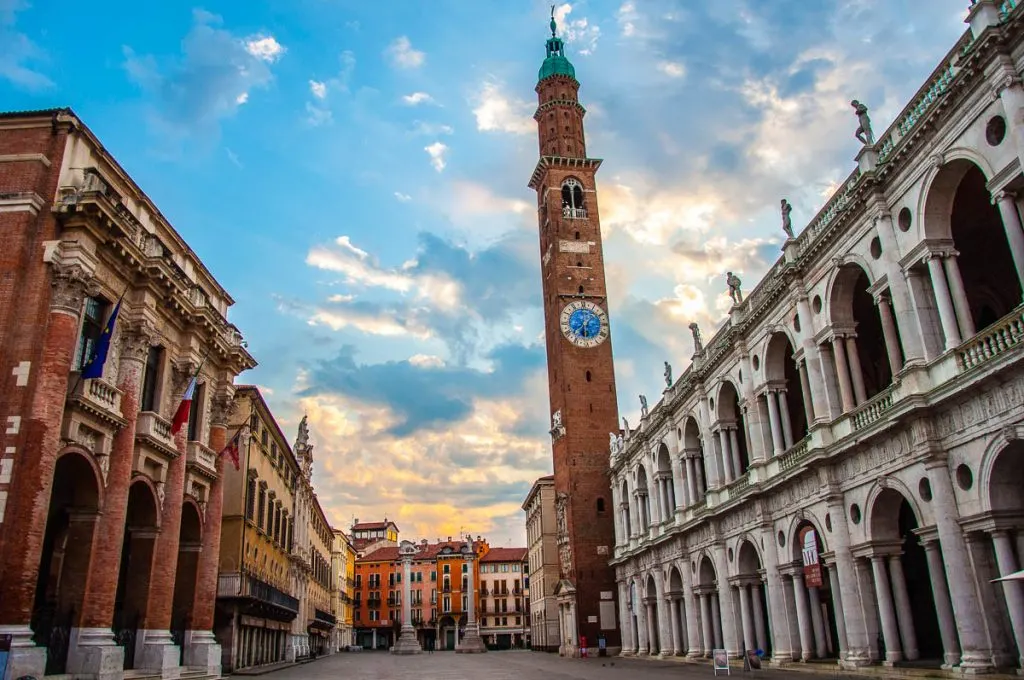
The best ways to explore Veneto is by road and railway.
In addition to the highways listed under the above point, the region is crisscrossed by a dense network of regional and provincial roads. They link the main cities, smaller towns, and little villages. Driving on them is free but it may take longer than on the highway as they go through many urbanised areas with restrictions on the speed limit.
If you are getting around by car, bear in mind that the historic centres of Veneto’s cities and towns are usually off-limits for cars and you may need to park a short walk away. Driving into a ZTL – limited traffic zone – will incur a large penalty. Keep an eye out for signs indicating that you are in the vicinity of a ZTL, as a GPS app may unwittingly guide you right through it.
Due to its urban plan and infrastructure, Venice is off-limits for cars but there are large car parks both on the island of Tronchetto and next to Piazzale Roma where you can pay to leave your vehicle for as long as you need.
Otherwise, Veneto’s cities and towns usually have good to excellent parking facilities. Paid car parks are easy to come across but it’s best to search on Google before your arrival to get an idea of where to park, what the cost will be, and how long you will need to walk to your hotel or the sights you want to see.
Free parking is also available but don’t rely on it too much during the high season. A piece of good advice is to always book accommodation that provides free parking and/or penalty-free access to the ZTL. Make sure that you ask at the time of booking.
Public transport in Veneto is well-organised. Bus lines operate in all cities and towns and connect them to the countryside. This is an easy and inexpensive way to travel around.
To quickly traverse Veneto, especially in terms of reaching its main and smaller cities and towns from one another, it’s best to take a train. High-speed trains (Frecciarossa, Frecciabianca, Frecciargento, and ItaloTreno) may cost up to three times more than the fast regional trains (treno regionale veloce) and the difference in time savings can be from negligible to small within the region. For example, from Padua to Vicenza by high-speed train is around 15 minutes and by fast regional train is 16-17 minutes. From Verona to Vicenza by high-speed train is around 25 minutes and by fast regional train is around 40 minutes.
It pays to get a high-speed train from Veneto to the neighbouring Italian regions, for example, from Venice to Milan, otherwise, the fast regional train is a very good option. Bear in mind that the regular regional train (treno regionale) is usually much slower than the fast one, so take it only if there is no other option.
To check train times and book train tickets in advance, I find the following three websites very useful: Omio, ItaloTreno, and TrenItalia.
Where to Stay in the Region of Veneto in Italy?
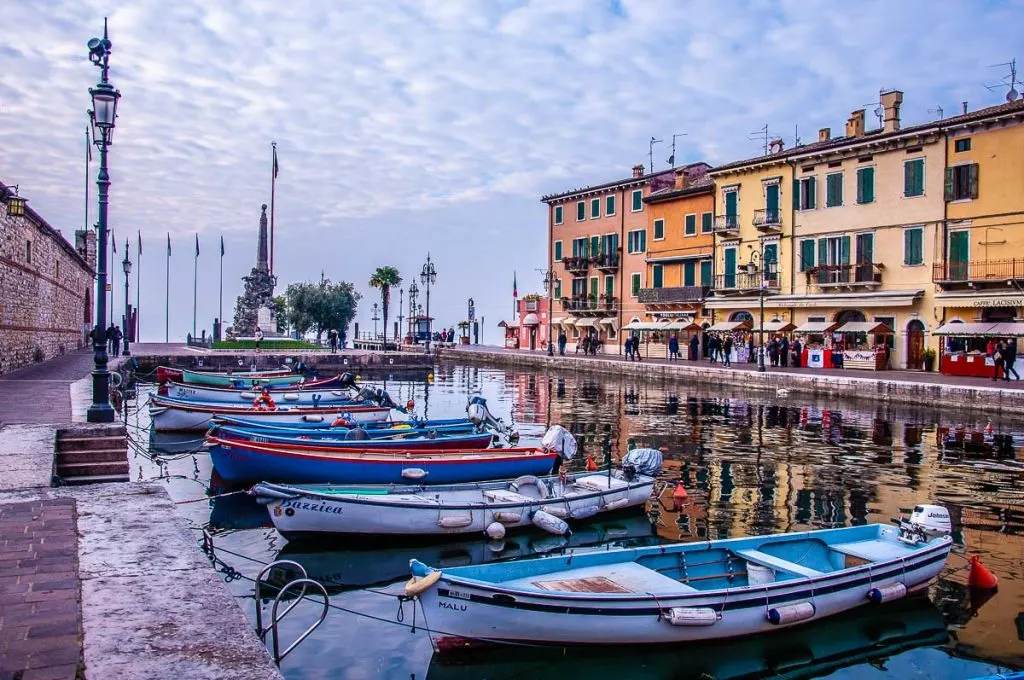
There is a huge selection of places to stay in Veneto in any season.
You can choose a historic palazzo that nowadays functions as a luxury guesthouse. You can opt for an elegant B&B in a convenient location. Or you may prefer a place with a unique view for that special romantic experience.
If your plan for Veneto includes lots of active sightseeing, then pick accommodation that is easy to get to in terms of public transport. If you travel by car, ask if the hotel provides free parking and penalty-free access to the ZTL (the limited traffic zone of the historic centre of the city).
Here are some specific suggestions for places to stay in Veneto. All come highly recommended:
Venice: Hotel L’Orologio – WTB Hotels, Casa Accademia
Verona: Hotel Accademia, Casa Panvinio
Padua: Canton del Gallo, Art Hotel Al Fagiano
Vicenza: Palazzo Scamozzi, Antico Hotel Vicenza
Lake Garda: Casa Beccherie (Lazise), C House Rooms Lake (Peschiera del Garda)
Alternatively, use this map to get a quick visual idea of the available accommodation options in the region of Veneto in Italy. You can zoom in and out, type in your specific travel dates, and then click on the different price points for detailed information about the hotel you want to know more about.
In addition, have a look at this blog post which explains the different types of accommodation you can book in Italy. It will give you plenty of ideas to look into for the best and quirkiest places to experience here:
What to Eat and Drink in the Region of Veneto in Italy?
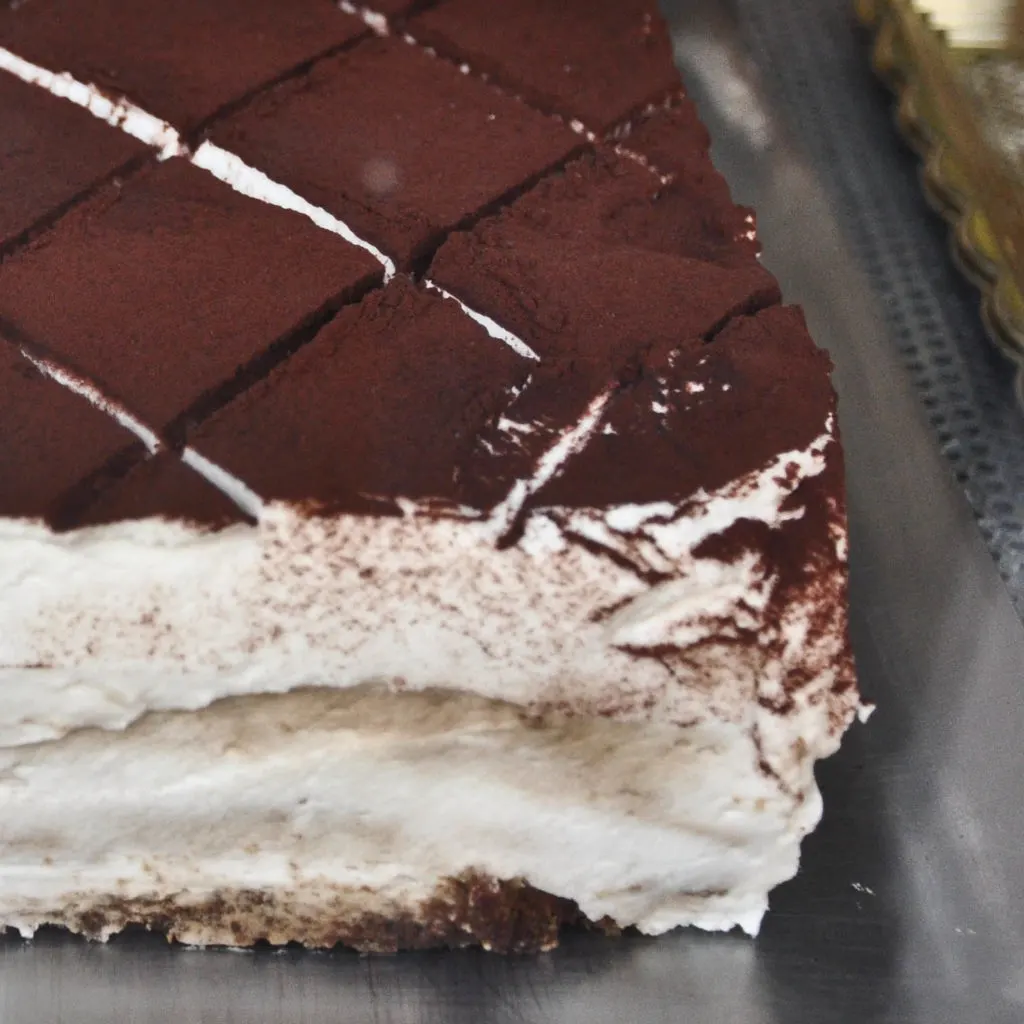
Veneto in Italy has its own cuisine which has taken centuries to develop and fine-tune. It is made of the dishes of the different provinces, cities, and towns in the region and has a lot of local nuances.
Every place here, no matter how small, has its own traditional delicacies. Their recipes and preparation methods are passed from generation to generation. For example, risotto di gò on the island of Burano, tortellini nodo d’amore in Borghetto sul Mincio, and pastissada de caval in Verona. Polenta and rice are staples on the local table.
The region is also known for its exquisite sweets and desserts. Tiramisu – originally created in the city of Treviso – is recognised as one of the most popular desserts in the whole world but there are many more choices for you to explore in Veneto if you have a sweet tooth. Try zaetti biscuits in Venice, dolce del Santo in Padua, and at Christmas treat yourself to a delicious pandoro from Verona.
Every province in Veneto is also known for its locally grown fruit and vegetables. The following are particularly prized – white asparagus from Bassano del Grappa, red radicchio from Treviso, purple artichoke from the island of Sant’Erasmo in the Venetian Lagoon, and cherries from the town of Marostica.
The most famous Italian food, pizza, is not traditionally Venetian but nowadays is a staple all around the region. In every city and town here you will find many pizzerias with wood-fired ovens. You can enjoy a pizza either as a sit-down meal or as an inexpensive takeaway. Bear in mind that in Venice, usually wood-fired ovens are not allowed and the pizza served there usually is not the best in Italy. So, it’s always better to try the local dishes.
To give you some ideas, here is a short list:
- bigoli – thick round strands of extruded pasta usually served with duck sauce or sardines.
- baccala’ alla vicentina – this typical for the city of Vicenza dish has a cult following. It is prepared with stockfish from the Lofoten Islands in Norway and served on a bed of polenta.
- risi e bisi – a creamy dish of rice and peas which is a big hit with the locals every spring. In the past, it was served to the Doge of Venice on St. Mark’s Day each year.
- sarde in saor – a type of pickled sardines prepared with onions, vinegar, and raisins. Very popular in Venice, it used to be eaten by the sailors staffing the ships of the Venetian Republic.
- tramezzini – these are triangular sandwiches of soft crustless bread stuffed with a generous portion of different fillings. They make for a nice inexpensive lunch on the go.
- cicchetti – Venetian bite-size snacks to savour with an ombra – a small glass of wine.
- torta fregolotta – it looks and tastes like shortbread but it has a much rougher texture. It’s made with flour, almond meal, sugar and cream.
In the late afternoon and early evening, order a classic Venetian spritz – a refreshing prosecco-based drink which gives you a nice little buzz. It is traditionally served with potato crisps and/or other finger foods.
The region of Veneto is also home to several famous wine-making areas. For example, Soave, Valpolicella, and the Prosecco Hills. If wine is your vice, you can sample many different ones and visit local vineyards and wineries to learn more about the process of winemaking.
What is Veneto Known for?
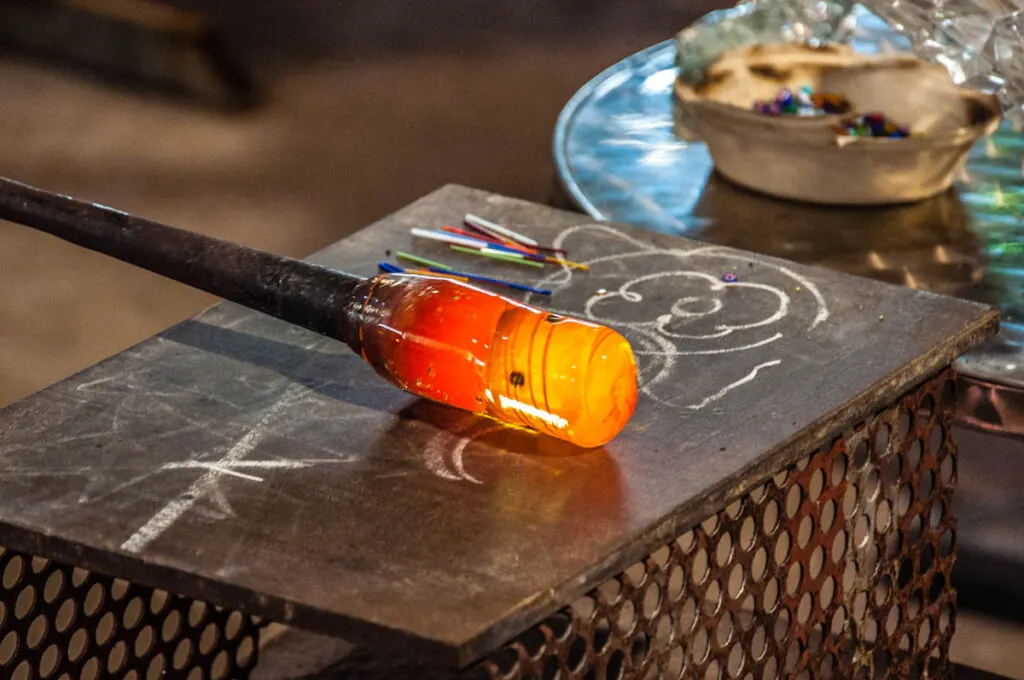
Veneto is known for its rich history, pristine nature, traditional crafts, rich artistic expression, and its capital city Venice.
This region in Italy is a delight to explore and depending on your interests, you can approach it from many different angles. If nature is your thing, head to the Dolomites, the Venetian Prealps, and Veneto’s hilly groups – the Colli Berici and the Colli Euganei. For crafts, explore the islands of Murano (glass) and Burano (lace), as well as the maskmaking workshops of Venice, the pottery factories in Nove, and the artisan jewellery shops in Vicenza.
For art, head to the region’s numerous museums and churches. Even the smallest ones of them preserve beautiful frescoes, paintings, and other works of art that can make you gasp with excitement. The well-known Gallerie dell’Accademia in Venice and the Scrovegni Chapel in Padua are a must-see but don’t miss smaller, lesser-known art destinations here. For example, the Sala dei Battuti and the Castle Museum in the small town of Conegliano or Palazzo Chiericati, Palazzo Leoni-Montanari, Teatro Olimpico, and the Church of Santa Corona in Vicenza.
Of course, Veneto is famous for many more things – its lakes, its historic heritage, its good food, its luxury goods, its shopping, and so on. The best course of action instead of simply reading about it is to come here and visit. This way you can see it for yourself and make your own Venetian memories to cherish forever.
What to See in Veneto in a Week? A Sample Itinerary!
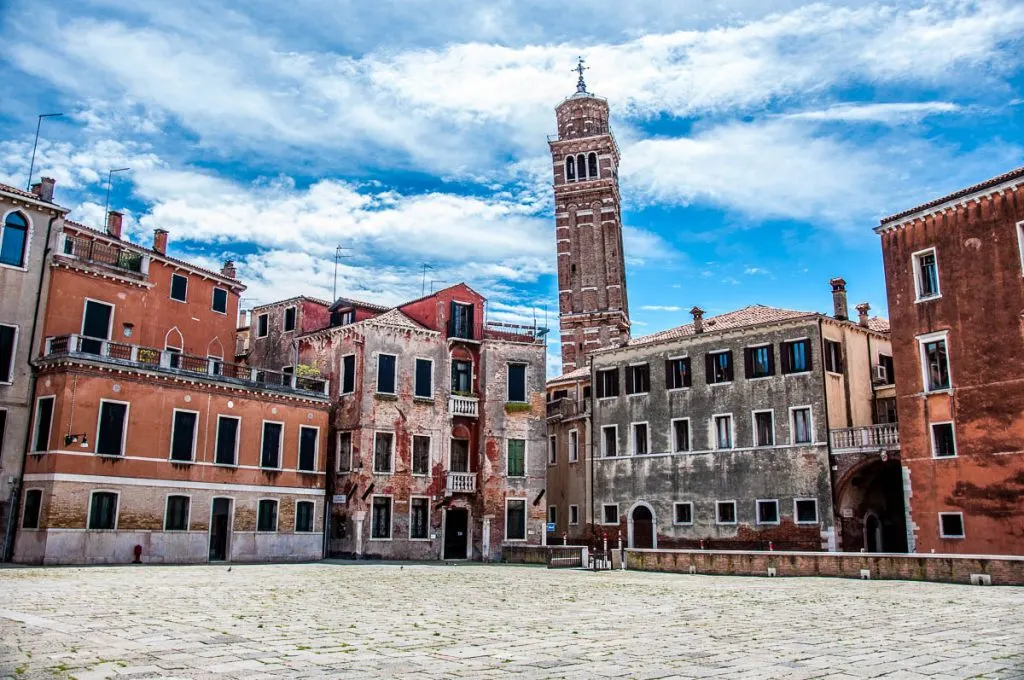
A week is a great length of time to get a taste of all that Veneto has to offer. With short travel distances between the main cities here, you can easily base yourself in one of them, for example, Padua or Verona, and then travel around by train to see as much as you can. Or you may prefer to spend three days in one of the main cities, two on the shores of Lake Garda, and then two more days somewhere in the countryside, for example, a cute village or a medieval walled town.
The choice is yours and it will depend on your interests, how active you want to be, and how often you want to change your base.
In any case, you will be surprised by how much you can get to see without wasting that much time on travelling. You can reach Vicenza from Padua, for example, in less than 20 minutes by train. This is shorter than most people’s commute to work! The distance from Verona to Lake Garda, also by train, is less than 15 minutes. There is no excuse not to take a day trip!
Here is a sample one-week itinerary for Veneto in Italy. I hope you find it useful as a starting point to make your own travel plans for this exciting northeastern Italian region.
One week in Veneto, Italy – Sample Itinerary
3 Days in Venice – 1 day spent exploring the city’s major landmarks, 1 day enjoying its artistic heritage, and 1 day as a day trip to the islands of Murano, Burano, and Torcello in the Venetian Lagoon.
2 Days in Padua – 1 day spent exploring Padua and 1 day as a day trip. For example, you can easily travel to either Vicenza, Treviso, Cittadella or Castelfranco Veneto.
2 Days in Verona – 1 day exploring Verona and 1 day as a day trip to Lake Garda. You can take the train to Peschiera del Garda and then the ferry to the nearby towns of Lazise, Bardolino, and Garda Town. Alternatively, you can take the shuttle bus which connects the train station of Peschiera del Garda to the large amusement park Gardaland.
Here are some specific blog posts to help you with travel planning:
Travel Planning: Venice to Padua, How to Get to Padua, Venice to Verona, Verona to Venice, Venice to Lake Garda, Verona to Lake Garda, How to Get Around Lake Garda,
Day Trips in Veneto: from Venice, from Padua, from Verona, from Vicenza
In Conclusion
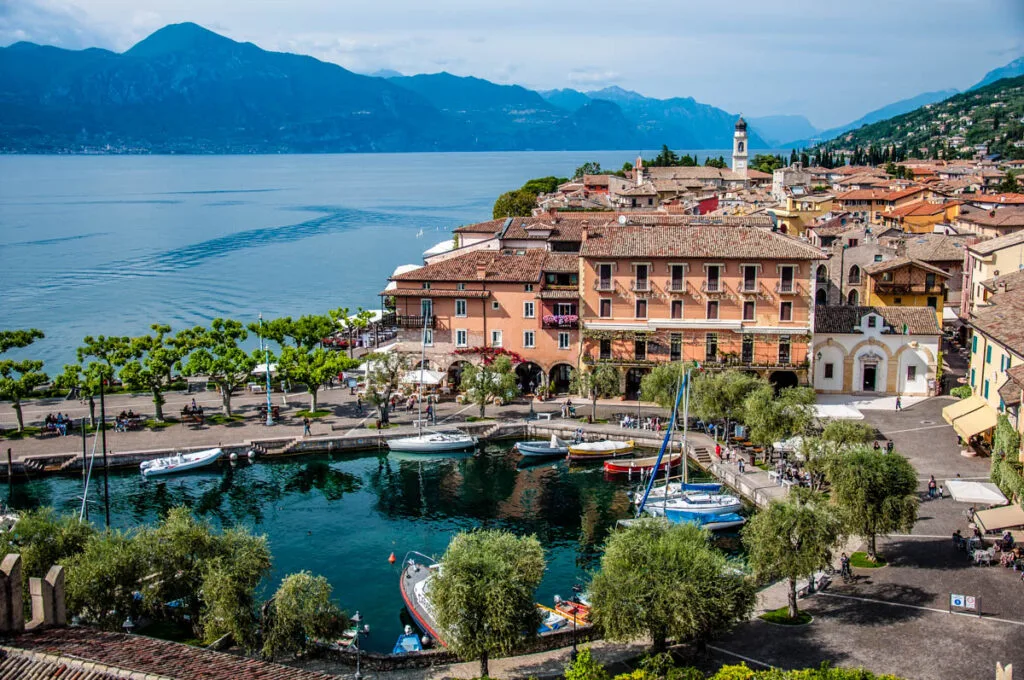
The region of Veneto is a wonderful destination in the northeast of Italy for a short break or a longer holiday either solo or with your family and friends. With millennial history, rich layers of art and culture, as well as pristine beaches and mountains, here you will find countless options to get active, sightsee, and feel refreshed.
Captained by its capital – the beautiful city of Venice – Veneto has a long list of other must-see destinations, too. From world-famous places to hidden gems, you will be spoilt for choice.
So, to give you plenty of exciting trip ideas and to help you plan your Italian holiday, in this blog post today I shared with you the 15 top places to visit in Veneto. In the page above, we discussed the region’s larger cities like Venice, Verona, and Padua, charming towns surrounded by medieval walls, its heritage – from Roman ruins to architectural masterpieces, as well as its share of the mighty mountain range of the Dolomites and Italy’s largest lake, the beautiful in any season Lago di Garda.
This was followed by an essential travel guide for Veneto in Italy – is it worth a visit, how to travel around the region, what to eat, and where to stay. It was all covered in some detail including a sample week-long itinerary to enjoy the best that Veneto has to offer.
I hope that all this information will give you just the impetus that you need to head to this charming corner of Italy and experience it for yourself.
Have a wonderful time in Veneto and let me know in the comments below which is your favourite destination and favourite thing to do here.
Click on the links further below for even more helpful information about the best things to do in Italy and its different regions!
Travel Tools
Get Ready for Your Trip to the Region of Veneto in Italy
Get a guidebook from Amazon.
Buy plane tickets, train tickets, and bus tickets through Omio.
Research accommodation on Booking.com.
Select local tours and activities on GetYourGuide, Viator, and Tiqets.
More Helpful Italy Info for You
Best of Italy: Italian Piazzas, Italian Markets, Accommodation for Every Budget, Best Times to Visit Italy, Italy in Summer, Italy with Kids
Italian Food: Best Italian Food Gifts, Cheap Italian Food, Rules of Italian Breakfast, Italian Breakfast Foods
Italian Coffee: Italian Coffee Culture, Italian Coffee Drinks, History of Coffee in Italy
Christmas in Italy: Fun Facts, Things to Do, Italian Nativity Scenes, Panettone, Christmas Guide
Northern Italy: Best Cities to Visit, Major Airports, Reasons to Visit
Lake Como: Travel Guide, Reasons to Visit in Winter, Best Towns, Best Things to Do, Milan to Lake Como, Nearest Airports, Getting Around Lake Como
Lake Garda Towns and Villages: Best Towns, Lazise, Desenzano del Garda, Riva del Garda, Malcesine, Torri del Benaco, Punta di San Vigilio, Campo di Brenzone, Borghetto and Valeggio sul Mincio
Visiting Lake Garda: Travel Guide, Map of Lake Garda, Getting Around Lake Garda, Lake Garda with Kids, 8 Best Airports, Venice to Lake Garda, Verona to Lake Garda, Milan to Lake Garda, Bologna to Lake Garda
Venice: Essential Tips, Things to Do, Major Landmarks, Hidden Gems, How to Navigate Venice, Venice in a Day for Art Lovers, Train Stations, Nearest Airports, Best Tours, Beaches of Venice, Quotes about Venice, Boats in Venice, Haunted Venice, Day Trips from Venice, Arco del Paradiso
Verona: Things to Do in One Day, Verona Opera Festival, Day Trips from Verona, Romeo and Juliet Itinerary, Verona to Venice, Verona to Milan
Padua: Things to Do in One Day, 101 Facts About Padua, 10 Reasons to Visit Padua, Day Trips from Padua, How to Reach Padua
Vicenza: Things to Do, Day Trips from Vicenza, Best Museums, The Beauty of Vicenza
Treviso: Travel Guide
Veneto: Top Places to Visit, Unique Adventures, Most Colourful Places, Mysterious Places, Most Beautiful Lakes, Reasons to Visit, Main Cities, Prettiest Small Towns, Most Beautiful Villages
Lombardy: Best Cities and Towns, Reasons to Visit, Brescia
Friuli Venezia Giulia: Venzone, Most Beautiful Villages
Emilia Romagna: Bologna, Ravenna, Comacchio, Most Beautiful Villages
Marche: Reasons to Visit, Gradara, Frasassi Caves, Temple of Valadier
Umbria: Reasons to Visit Perugia
Campania: Naples
Thank you for reading! Leave me a comment, pin the images or use the buttons right at the top and at the end of this blog post to share it on social media.
For more useful information like this, you can follow my blog’s page on Facebook and Instagram and subscribe to my strictly no-spam newsletter.
Pin This Blog Post!
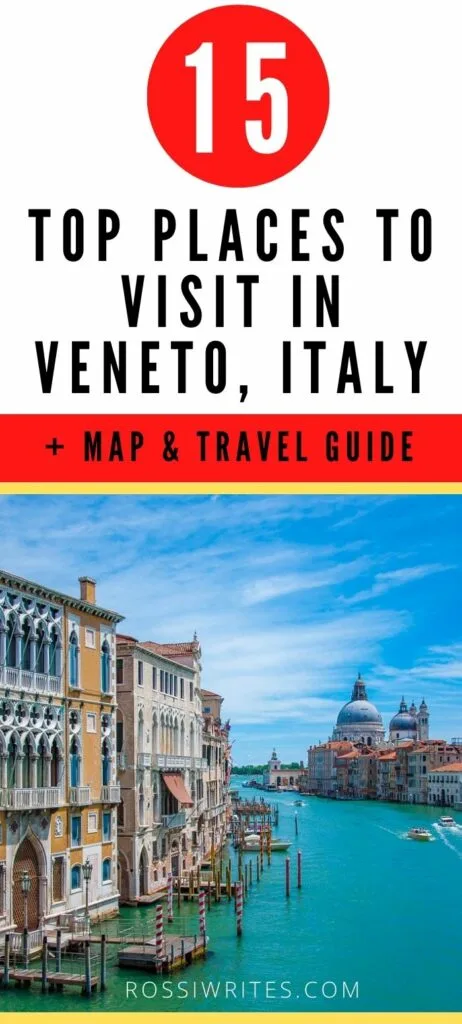
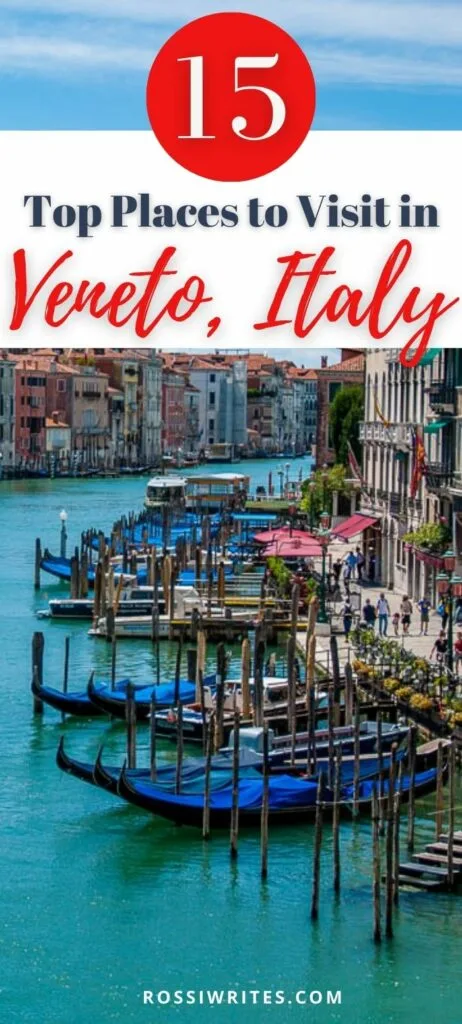

Belinda
Tuesday 26th of February 2019
Hi and thanks for this article...planning on a few nights mid October in Veneto. Flight landing aro7nd 2 pm...Venice airport. Torn between...train to Padua, stay day and night, train to VERONA 2 nights... Afternoon and Evening in Venice , early train to Padua for day (store luggage in station). Late afternoon train to VERONA for 2 night, one full day.(was in Venice few nights last year but LOVE it.). OR..straight to VERONA by train..stay 3 nights as base and daytrip to Padua and maybe somewhere else. Female, early 50’s travelling alone . Love your thoughts. Hard to be at Venice station and not stay Thanks Belinda
admin
Tuesday 26th of February 2019
Dear Belinda,
Thank you for stopping by and for your comment! Venice is my favourite city in the world. I find that there is always something new and exciting to see and learn there. At the same time, Padua and Verona and the whole of the Veneto as a fact have a lot to offer to the inquisitive visitor. It really depends on one's personal interests - art, history, architecture or nature hikes, local traditions and authentic food. Having said that, I also need to say that this is a personal blog, I am not a travel agent or skilled in giving personalised travel advice. I write based on my personal experiences and what I have seen, tried and loved myself. As such, I am really sorry but it would be beyond my remit to give you advice especially as I don't know you personally. I hope you understand. Have a great time in Italy and the Veneto! Best wishes,
Rossi
Ashley L Novak
Thursday 31st of January 2019
Hi Rossi,
I'm so happy I found your blog. I am from Washington, DC but will be spending 3 nights in Bassano del Grappa in May. 10 years ago when I was in University, I studied for a few months in a very small town, Paderno del Grappa. I am staying in Bassano to tour the area again, with my now husband, celebrating our 5th wedding anniversary. I am so excited to see the small towns in the Veneto again. I've never been to Vicenza, but may plan a day trip there from Bassano one night, maybe Padua as well. Are there any special spring festivals in May in the Veneto towns? We will be in Bassano May 19th-22nd.
I just wanted to say you have such great content and beautiful pictures on your blog. Thank you for sharing your talents :)
Looking forward to visiting the Veneto, Ashley
admin
Saturday 2nd of February 2019
Dear Ashley,
Thank you so much for your very kind message! It's wonderful that you will be returning to Italy, especially to such a beautiful town as Bassano del Grappa. In terms of festivals and events, here is a very useful link (https://www.giraitalia.it/veneto/maggio.html) listing all types of events and happenings in the Veneto in May. It's in Italian but (if need be) with Google Translate you can easily read through it. Another option is to check the Events section on Facebook closer to your travel dates. There will be all sorts of things listed there, too: from food festivals and exhibitions to historical reenactments. Thank you again for stopping by and for your very kind words! Have a great time in Italy! Best wishes,
Rossi :)